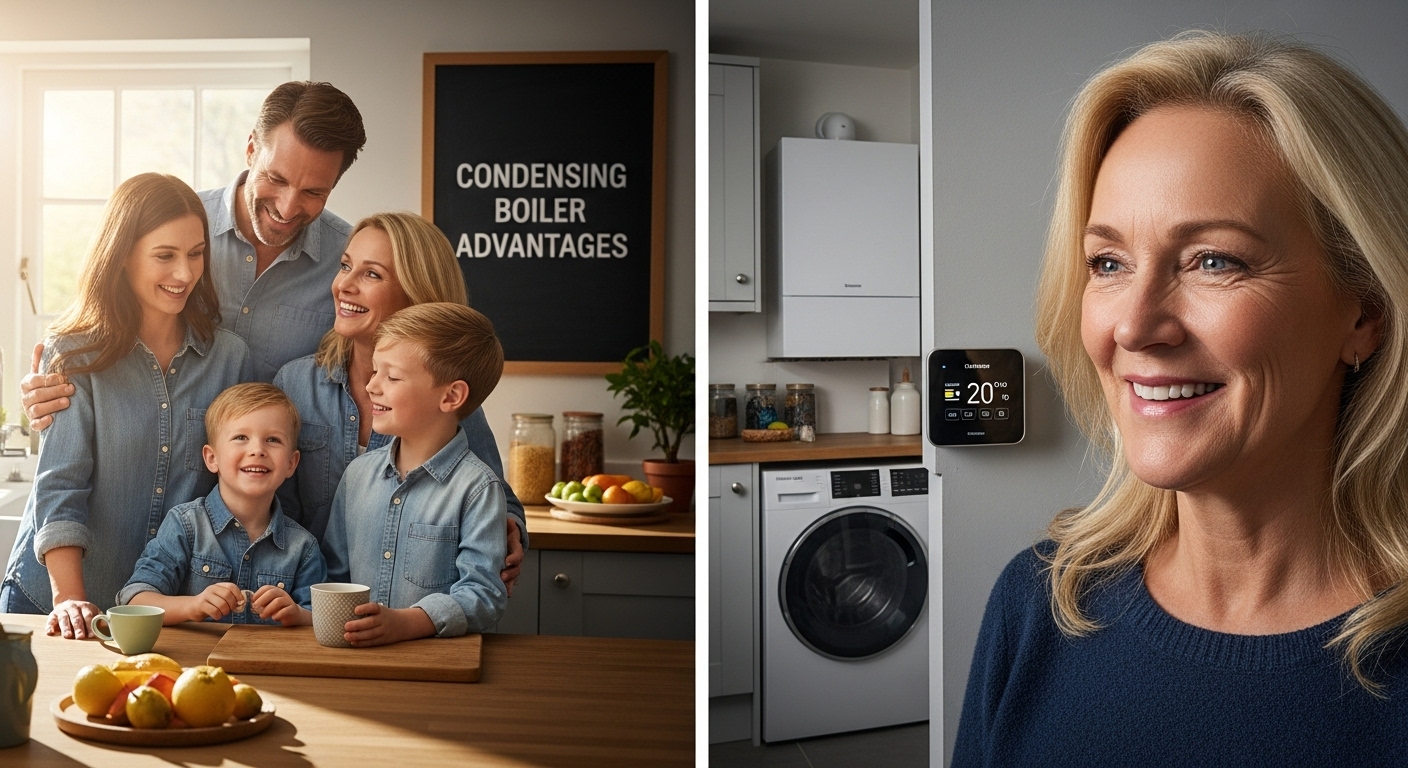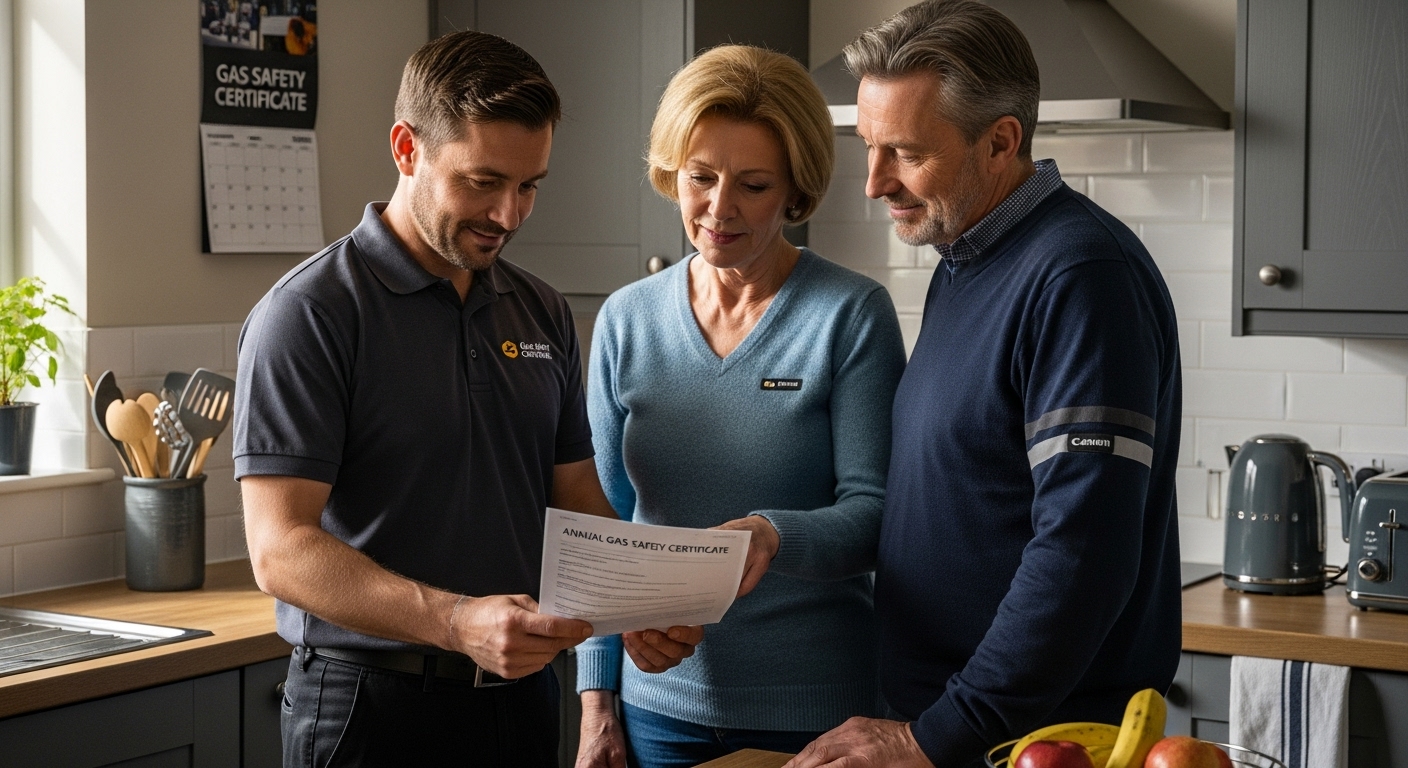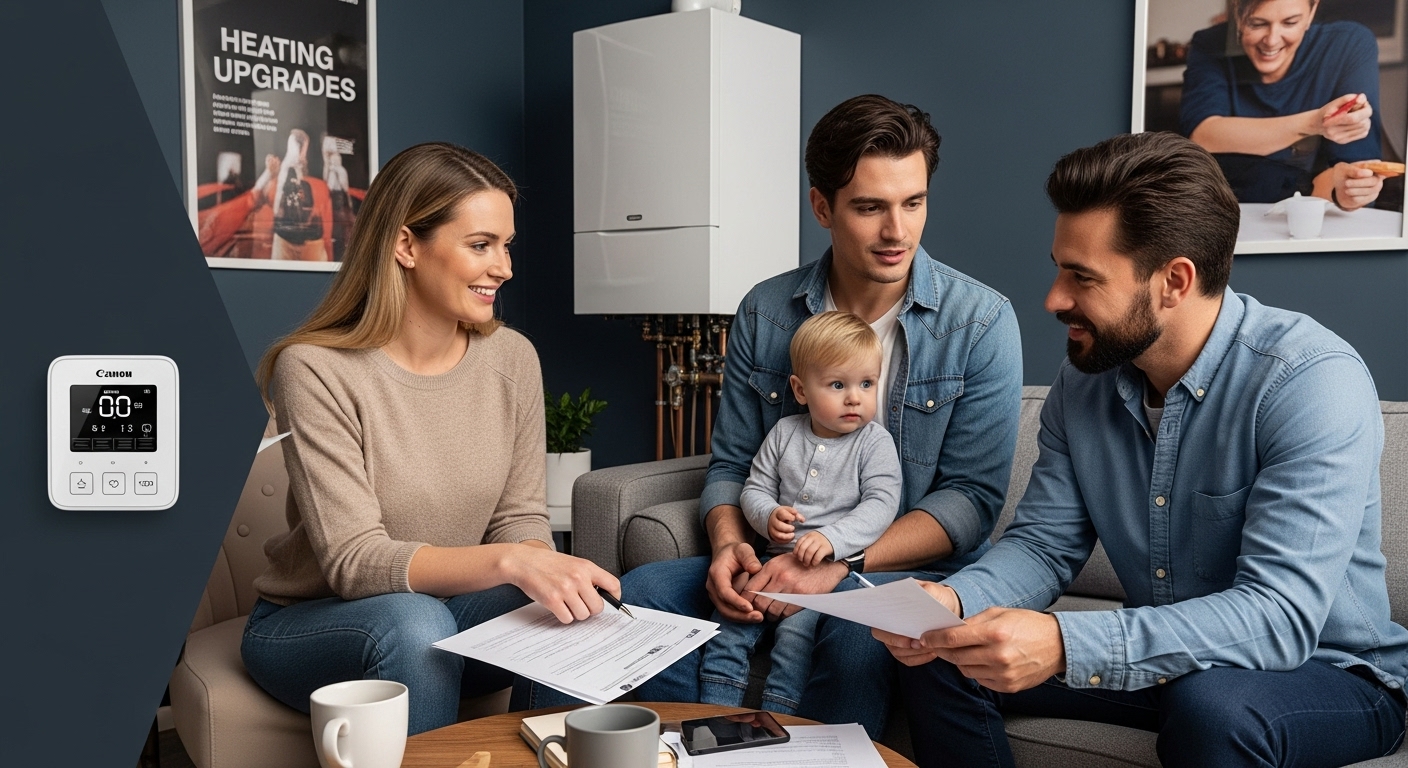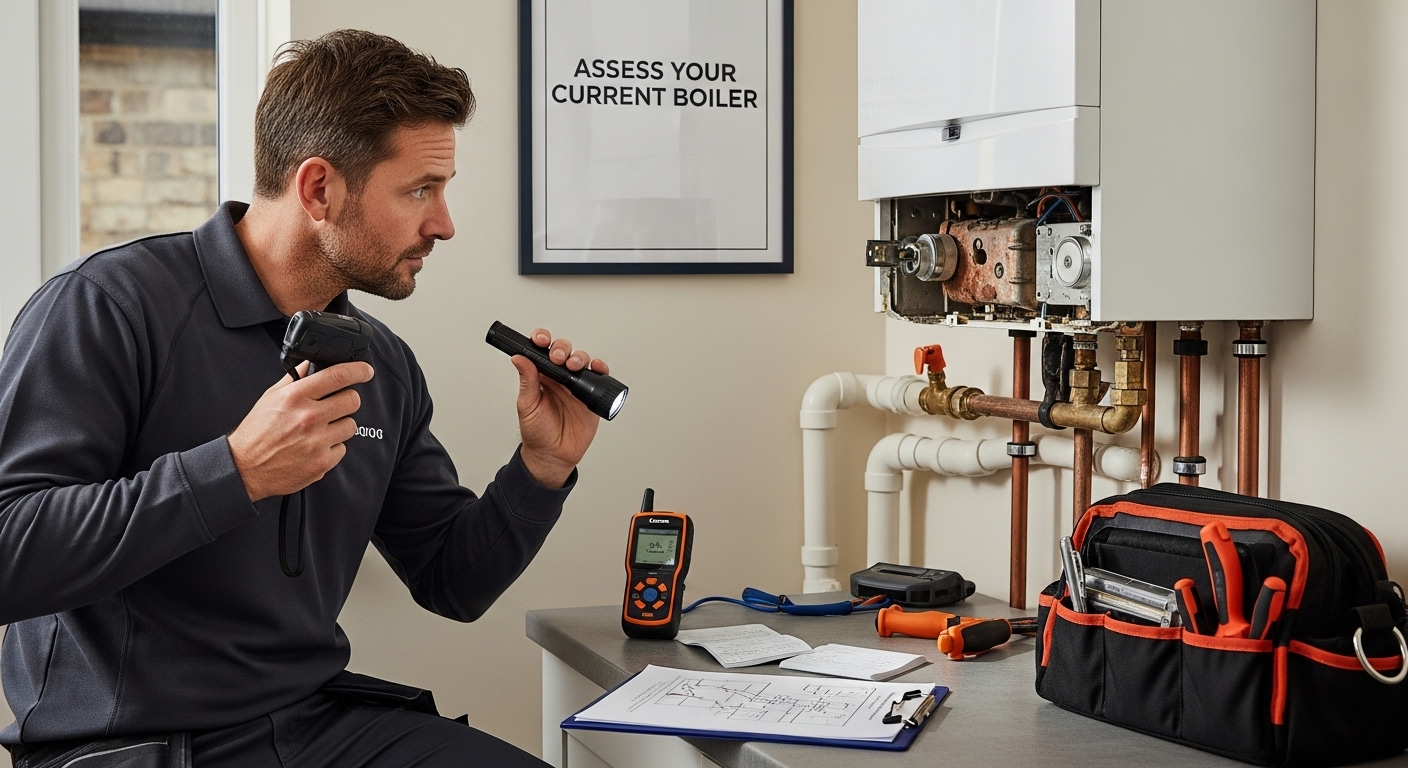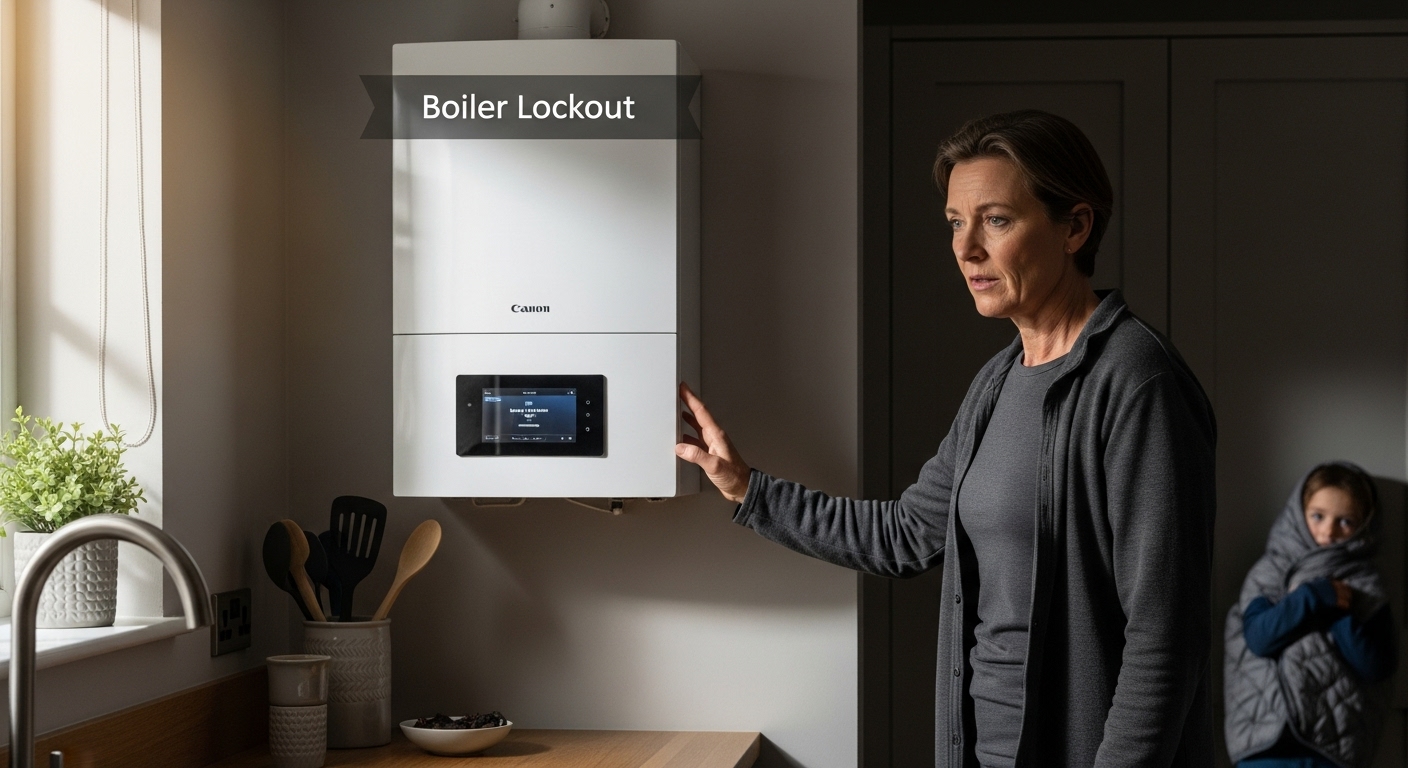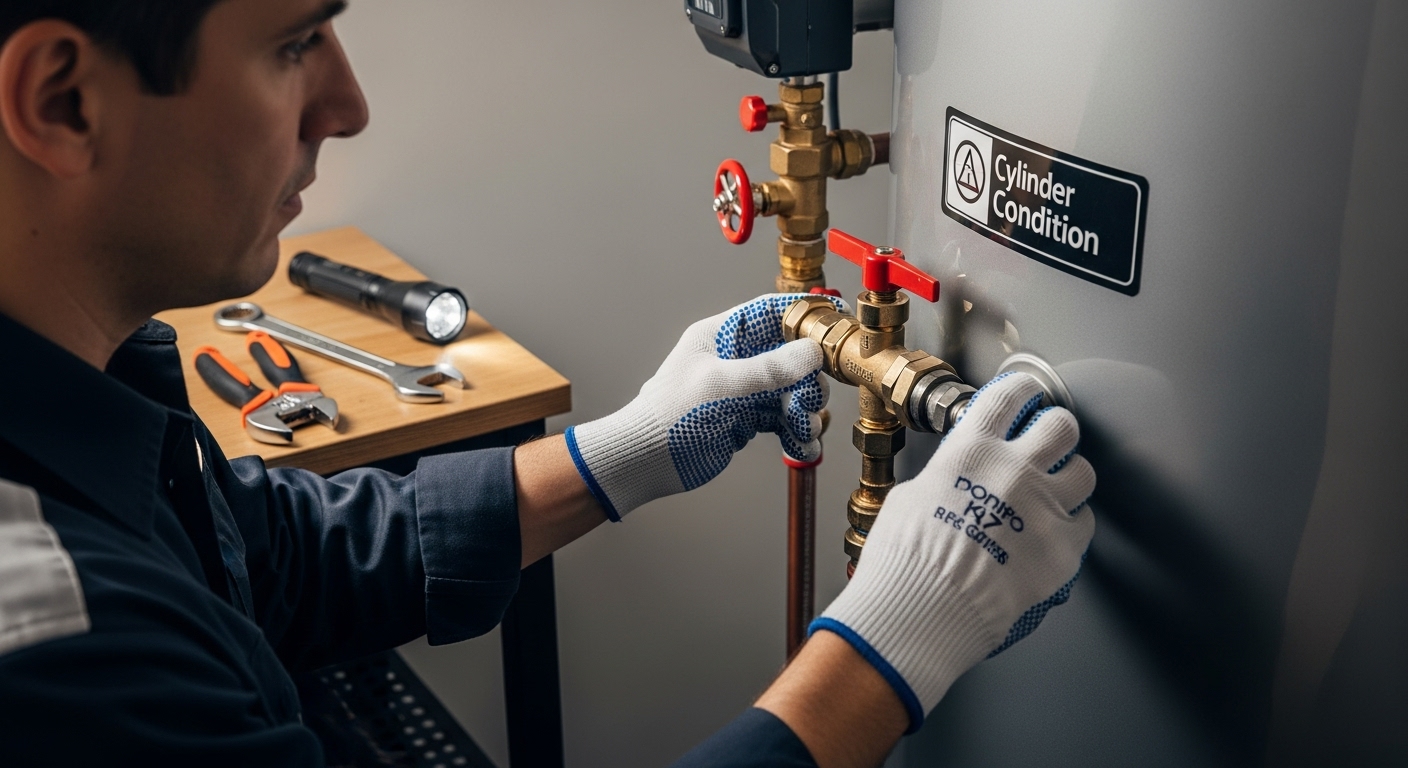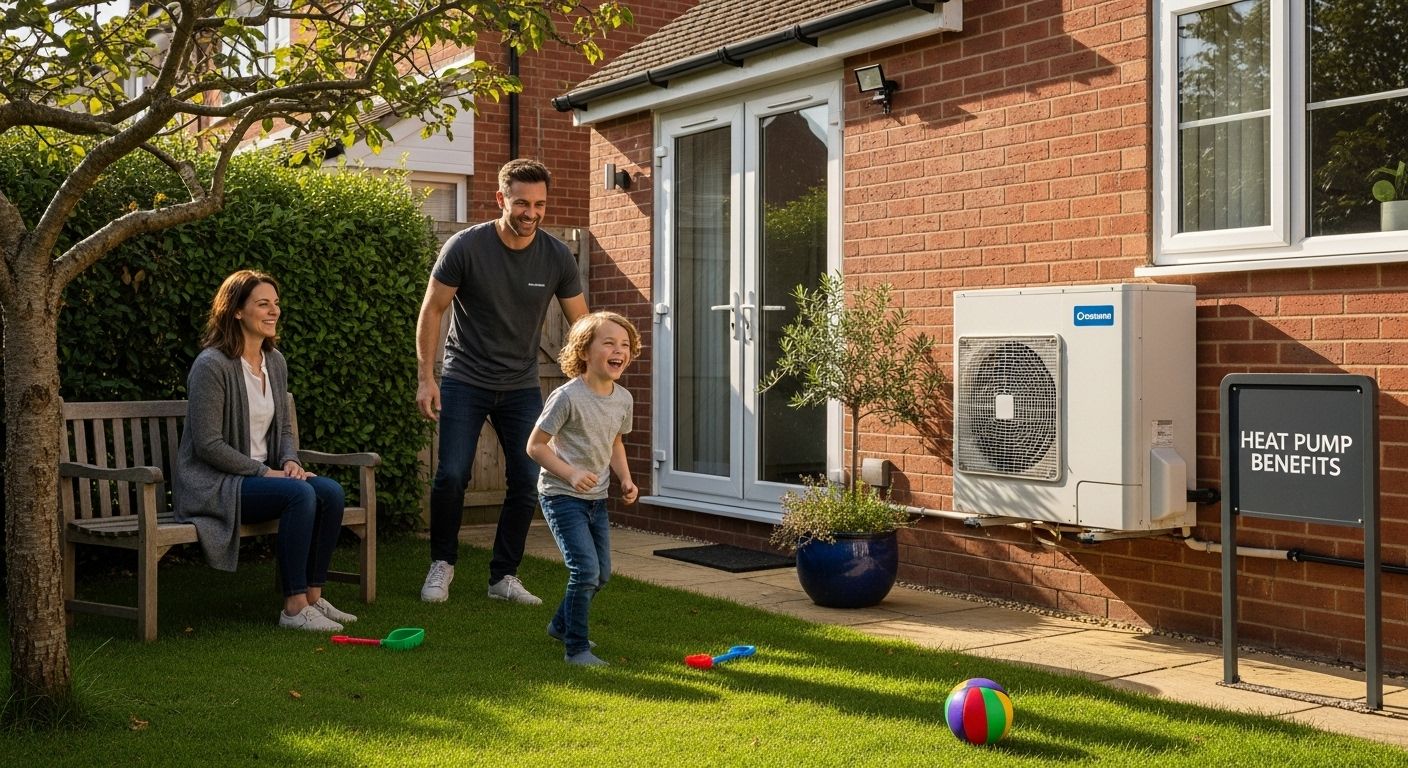Which Heating System is Best? Understanding Your Options
Choosing how to heat your home can shape not just your comfort, but your wallet too and almost 90% of people in the UK now say heating affordability is a top priority. Most expect gas boilers are the only real contender for warm living rooms when it gets cold. Yet new systems like heat pumps and renewables can cut monthly energy bills by as much as 30% and dramatically reduce emissions. The surprise is that the modern options might just trump tradition in ways most homeowners never see coming.
Table of Contents
- Understanding Different Types Of Heating Systems
- Importance Of Choosing The Right Heating System
- How Heating Systems Operate: Key Concepts Explained
- Comparing Efficiency And Costs Of Heating Options
- The Role Of Renewable Energy In Heating Solutions
Quick Summary
| Takeaway | Explanation |
|---|---|
| Select heating system wisely | Choosing the right system affects comfort, costs, and efficiency. Align your choice with property needs and budget constraints. |
| Consider long-term costs | Evaluate installation costs alongside ongoing operational expenses. Some systems may save money over time despite higher upfront costs. |
| Embrace renewable technologies | Utilize renewable heating systems to reduce carbon footprints and enjoy substantial environmental benefits. They often qualify for government incentives. |
| Focus on efficiency ratings | Higher efficiency ratings can significantly reduce energy bills. Look for systems that optimise energy usage for better financial outcomes. |
| Seek professional guidance | Consultation with heating experts can clarify options, helping to balance energy efficiency, cost, and personal comfort needs effectively. |
Understanding Different Types of Heating Systems
Heating systems are essential infrastructure for maintaining comfortable living spaces, especially in regions with variable climates like the United Kingdom. The Energy Saving Trust provides comprehensive insights into the various heating technologies available for residential and commercial properties.
Central Heating Systems
Central heating represents the most common approach to warming homes in the UK. These systems distribute heat through a network of pipes and radiators connected to a central heat source. The primary types include:
- Gas boilers (most prevalent in UK households)
- Oil boilers
- Liquefied petroleum gas (LPG) boilers
- Biomass boilers using renewable wood-based fuel
Each system operates by heating water that circulates through radiators and provides warmth to different rooms. Gas boilers remain the most popular due to their efficiency and relatively lower operational costs.
Electric and Alternative Heating Technologies
Beyond traditional central heating, modern technologies offer alternative warming solutions. nidirect highlights innovative approaches like heat pumps, which extract environmental heat and convert it into usable warmth. These systems include:
- Air source heat pumps
- Ground source heat pumps
- Water source heat pumps
These technologies represent more sustainable options, drawing heat from ambient air, ground temperatures, or water sources. They typically consume less electricity compared to traditional electric heaters and contribute to reduced carbon emissions.
Heat Network Solutions
Heat networks provide another sophisticated heating approach, particularly suitable for urban environments. UK Government publications explain these systems distribute heat from a centralized source to multiple buildings. This method can utilize diverse low-carbon heat sources like industrial waste heat, geothermal energy, or river-sourced thermal energy.
Understanding these heating systems helps homeowners make informed decisions about energy efficiency, environmental impact, and long-term heating strategy.
The following table compares the main types of domestic heating systems discussed, summarising their typical efficiency, running costs, and environmental impact.
| Heating System | Typical Efficiency | Running Costs | Environmental Impact |
|---|---|---|---|
| Gas Boiler | Moderate to High | Low | Moderate (fossil fuel) |
| Oil Boiler | Moderate | Moderate | Higher (fossil fuel) |
| LPG Boiler | Moderate | Moderate | Higher (fossil fuel) |
| Biomass Boiler | High | Moderate | Low (renewable fuel) |
| Electric Heater | Low | High | Variable (depends on grid) |
| Air Source Heat Pump | High | Low | Low (renewable energy) |
| Ground Source Heat Pump | Very High | Very Low | Very Low (renewable) |
| Heat Network | Variable | Low to Moderate | Low (can be low-carbon) |
Importance of Choosing the Right Heating System
Selecting an appropriate heating system is a critical decision that impacts household comfort, energy efficiency, and long-term financial expenditure. The University of Bath research highlights that nearly 90% of UK residents consider affordable home heating a significant priority.
Financial Implications
The financial consequences of selecting a heating system extend far beyond initial installation costs. Inefficient heating technologies can substantially increase annual energy expenses. Homeowners must consider multiple financial factors:
- Initial installation expenses
- Ongoing operational costs
- Maintenance and repair requirements
- Energy efficiency ratings
- Potential government incentives or grants
A strategically chosen heating system can reduce monthly utility bills by up to 30%, representing substantial long-term savings for households.
This table outlines key criteria for selecting a heating system, highlighting financial, environmental, and comfort-related implications as mentioned in the article.
| Criterion | Considerations | Example Impacts |
|---|---|---|
| Installation Cost | Upfront expenditure for system setup | High for heat pumps, lower for gas boilers |
| Operational Expenses | Monthly/annual cost to run the system | Up to 30% savings with efficient technologies |
| Environmental Impact | Emissions and sustainability | Reduced carbon with renewables |
| Maintenance Requirements | Expected servicing and repairs | Biomass needs regular maintenance; heat pumps less |
| Comfort & Performance | Room temperature consistency, control, noise levels | Zonal heating, quick warming, smart controls |
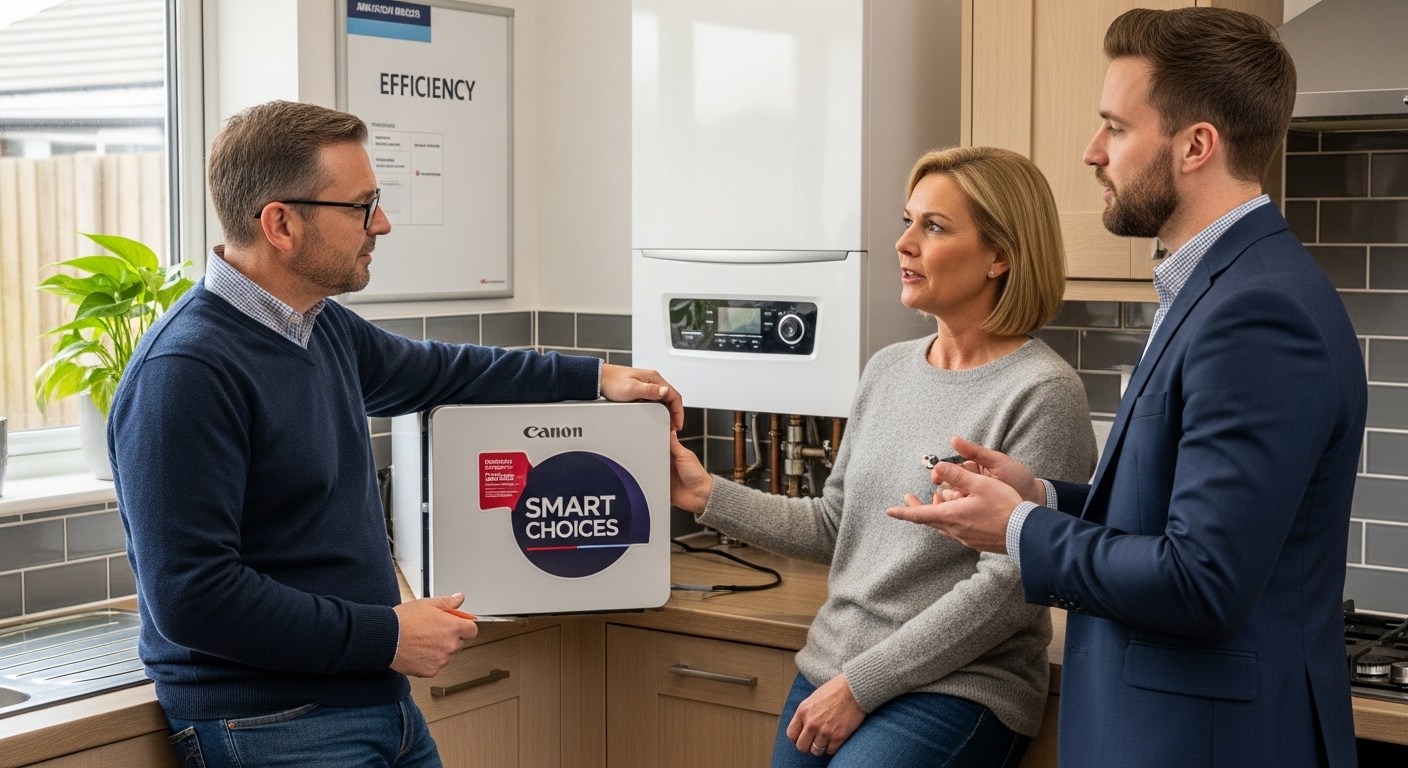
Environmental Considerations
Modern heating choices directly influence carbon emissions and environmental sustainability. The Energy Saving Trust emphasizes that over half of typical household fuel bills are dedicated to heating and hot water, making sustainable solutions increasingly crucial.
Environmentally conscious heating systems offer significant benefits:
- Reduced carbon footprint
- Lower greenhouse gas emissions
- Compatibility with renewable energy sources
- Potential eligibility for green technology incentives
Comfort and Performance Factors
Beyond financial and environmental considerations, the right heating system ensures consistent home comfort. Factors like heat distribution, temperature control, and adaptability to different living spaces play crucial roles in system selection.
Key performance indicators include:
- Consistent room temperature
- Quick heating capabilities
- Zonal heating options
- Compatibility with smart home technologies
- Noise levels during operation
Ultimately, selecting the right heating system requires carefully balancing personal needs, property characteristics, budget constraints, and long-term sustainability goals. Homeowners benefit from comprehensive research and professional consultation to make informed decisions that provide optimal comfort, efficiency, and value.
How Heating Systems Operate: Key Concepts Explained
Heating systems transform energy into warmth through complex yet fascinating mechanisms that ensure comfortable indoor environments. The Institution of Engineering and Technology explains the fundamental principles underlying thermal energy generation and distribution.
Heat Generation Principles
Thermal energy conversion represents the core mechanism of heating systems. These technologies transform various energy sources into usable heat through sophisticated processes. The primary methods of heat generation include:
- Combustion of fossil fuels (gas, oil, coal)
- Electrical resistance heating
- Heat pump technology
- Renewable energy conversion
Each method involves transferring energy from one form to another, with efficiency determined by the specific technological approach and energy source utilized.
Heat Transfer Mechanisms
Heating systems employ three primary methods of heat transfer: conduction, convection, and radiation. Conduction occurs when heat moves directly through solid materials, such as metal pipes or radiator surfaces. Convection involves heat movement through fluid mediums like air or water, which circulate warmth throughout living spaces.
- Radiators distribute heat through water circulation
- Underfloor heating uses radiant heat transfer
- Forced air systems move heated air through ductwork
- Infrared heaters generate direct radiant warmth
Control and Distribution Systems
Modern heating technologies integrate sophisticated control mechanisms to optimize energy usage and maintain consistent temperatures. Smart thermostats and zonal heating controls allow precise management of thermal environments.
- Temperature sensors monitor ambient conditions
- Programmable timers enable scheduled heating
- Zone-based controls permit differential room temperatures
- Integrated weather compensation technologies
Understanding these operational principles enables homeowners to make informed decisions about heating technologies, recognizing that efficient systems balance technological complexity with practical energy management. The interplay between generation, transfer, and control determines a heating system’s overall performance and effectiveness.
Comparing Efficiency and Costs of Heating Options
Heating technologies vary significantly in their operational efficiency, installation expenses, and long-term economic implications. UK Government research provides comprehensive insights into the financial landscape of different heating solutions.
Initial Investment and Installation Costs
Installation expenses represent a critical consideration when selecting a heating system. Different technologies require varying upfront investments:
- Gas boilers: Relatively low initial installation costs
- Air source heat pumps: Moderate to high installation expenses
- Ground source heat pumps: Highest initial investment
- Electric storage heaters: Moderate installation costs
Homeowners must balance immediate financial requirements with long-term energy efficiency potential. While some systems demand higher upfront expenditure, they can offer substantial savings over their operational lifecycle.
Operational Efficiency and Running Costs
The annual running costs of heating systems differ dramatically based on energy source, technological efficiency, and household requirements. Energy efficiency ratings play a crucial role in determining ongoing expenses:
- Gas boilers: Typically most cost-effective for larger homes
- Heat pumps: Higher efficiency, lower carbon emissions
- Electric heating: Generally most expensive to operate
- Biomass systems: Competitive costs with renewable fuel sources
Factors such as home insulation, system age, and maintenance practices significantly influence overall operational efficiency and associated expenses.
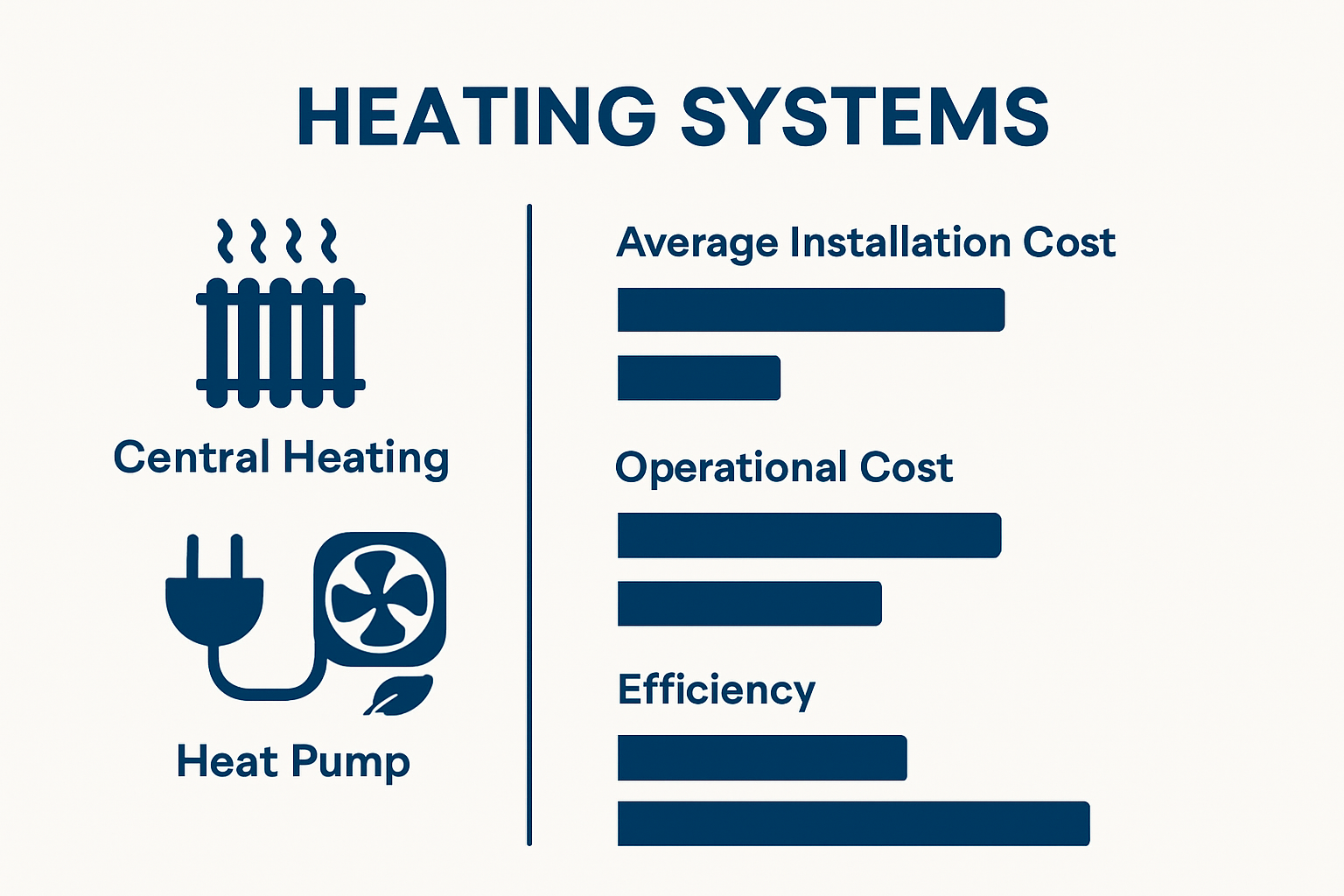
Environmental and Long-Term Financial Considerations
Modern heating choices extend beyond immediate financial implications. Sustainable technologies increasingly offer economic incentives through government grants, lower carbon taxes, and reduced environmental impact.
- Renewable energy compatibility
- Potential government incentives
- Carbon emission reduction
- Future-proofing against energy price fluctuations
- Potential property value enhancement
Selecting a heating system requires a holistic approach, considering not just current costs but anticipated technological developments, environmental regulations, and long-term household energy strategies. Professional consultation can help homeowners navigate these complex considerations and make informed decisions tailored to their specific requirements.
The Role of Renewable Energy in Heating Solutions
Renewable energy technologies are transforming the heating landscape, offering sustainable alternatives to traditional fossil fuel-based systems. UK Government initiatives demonstrate a growing commitment to supporting low-carbon heating technologies.
Renewable Heating Technologies
Renewable energy sources provide innovative solutions for residential and commercial heating needs. These technologies harness natural energy processes to generate warmth with minimal environmental impact:
- Solar thermal systems
- Ground source heat pumps
- Air source heat pumps
- Biomass heating systems
- Geothermal energy technologies
Each technology captures energy from natural sources, converting ambient heat or solar radiation into usable thermal energy with significantly reduced carbon emissions compared to conventional heating methods.
Environmental and Economic Benefits
Renewable heating solutions offer substantial advantages beyond traditional energy generation. Carbon reduction stands as a primary benefit, with these technologies providing measurable environmental improvements:
- Dramatically reduced greenhouse gas emissions
- Lower dependence on fossil fuel infrastructure
- Decreased household carbon footprint
- Potential for long-term energy cost stabilization
- Alignment with national climate change mitigation strategies
Homeowners investing in renewable heating technologies contribute directly to broader environmental sustainability goals while potentially benefiting from government incentives and reduced energy expenses.
Integration and Future Potential
The future of heating lies in integrated renewable energy systems that combine multiple technologies for maximum efficiency. Smart home technologies and advanced energy management systems are increasingly enabling more sophisticated approaches to thermal energy generation:
- Hybrid heating systems
- Smart grid integration
- Energy storage solutions
- Adaptive temperature control mechanisms
- Predictive maintenance technologies
As renewable technologies continue to advance, they promise increasingly sophisticated, efficient, and environmentally responsible heating solutions. The transition represents not just an environmental imperative but a significant opportunity for technological innovation in domestic and commercial energy management.
Discover Your Ideal Heating Solution With Trusted Local Experts
Making the right choice for your heating system can feel overwhelming. You want reliable warmth, lower energy bills, and a system that matches your home’s needs. The article emphasises the importance of balancing efficiency, cost, and sustainability. Many homeowners worry about high running expenses, outdated boilers, or the environmental impact of their current setup. Understanding concepts like heat transfer, system efficiency, and renewable integration is only the first step. To truly achieve comfort and savings, you need a skilled team to guide you through installation, repairs, and modern upgrades.
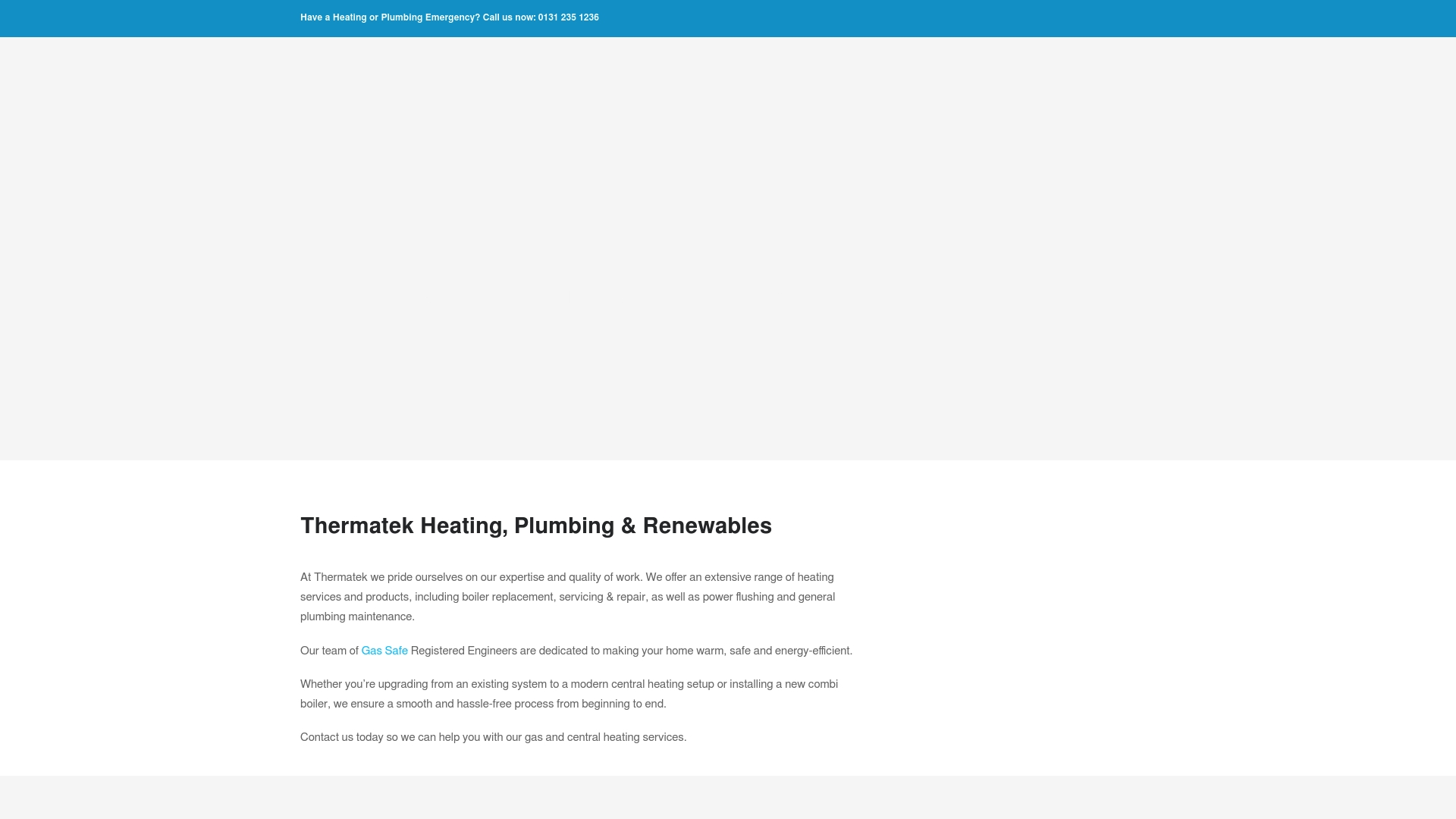
Why put your comfort and energy budget at risk with guesswork? The team at Thermatek Heating gives you access to experienced Gas Safe Registered engineers and a full portfolio of services. From boiler replacements and servicing to renewable upgrades like air source heat pumps and solar thermal, we help you choose and maintain the best system for your home. Book your free quote today and take control of your comfort and costs for the seasons ahead.
Frequently Asked Questions
What types of heating systems are available?
There are several types of heating systems, including central heating systems (gas, oil, LPG, and biomass boilers), electric heating options (like storage heaters), and alternative technologies such as heat pumps (air source, ground source, and water source). Each has its unique benefits and suitability depending on your home’s requirements.
How do heat pumps work and what are their benefits?
Heat pumps work by extracting heat from environmental sources (air, ground, or water) and converting it into usable warmth for your home. They are more energy-efficient than traditional systems and produce lower carbon emissions, making them a sustainable heating option.
What should I consider when choosing a heating system?
When selecting a heating system, consider factors such as initial installation costs, ongoing operational expenses, energy efficiency ratings, environmental impact, and compatibility with your property’s features and lifestyle needs.
How can I improve the efficiency of my heating system?
Improving heating efficiency can be achieved through adequate insulation, regular maintenance, using programmable thermostats for better temperature control, and ensuring your system is suitable for your home’s layout. Upgrading to modern, energy-efficient technologies can also significantly enhance overall performance.
Recommended
Understanding Condensing Boiler Advantages for Homeowners
Condensing boilers are reshaping the way homes stay warm across Britain, using smart design to slash fuel bills and shrink carbon footprints. You might think old boilers are still keeping pace, but the difference is staggering. With condensing models achieving up to 95 percent energy efficiency compared to just 55 percent for older boilers, the numbers show why upgrading has quickly moved from a luxury to a must for modern households.
Table of Contents
- What Is A Condensing Boiler And How Does It Function?
- Why Are Condensing Boilers Important For Home Heating?
- How Do Condensing Boilers Improve Energy Efficiency?
- What Are The Environmental Benefits Of Condensing Boilers?
- How Do Condensing Boilers Compare To Traditional Heating Systems?
Quick Summary
| Takeaway | Explanation |
|---|---|
| Condensing boilers achieve up to 95% efficiency | Unlike traditional boilers, condensing boilers capture and reuse heat, maximising energy efficiency significantly. |
| Homeowners can save around £320 annually | Upgrading to a condensing boiler can substantially reduce heating bills due to its high efficiency. |
| Lower carbon emissions contribute to sustainability | Condensing boilers significantly reduce greenhouse gases, supporting environmental goals and lowering individual carbon footprints. |
| Initial costs offset by long-term savings | Despite higher installation costs, the savings on energy bills lead to more economical use over time. |
| Support for renewable energy integration | Condensing boilers enhance energy efficiency and align with emerging sustainability frameworks and regulations. |
What is a Condensing Boiler and How Does it Function?
A condensing boiler represents a highly advanced heating technology designed to maximise energy efficiency and reduce carbon emissions in residential and commercial heating systems. Unlike traditional boilers, these innovative heating units capture and reuse heat that would typically be lost through exhaust gases, transforming how we approach home heating.
The Core Principle of Heat Recovery
At the heart of a condensing boiler’s functionality is an ingenious heat recovery mechanism. According to the European Union’s energy regulations, these boilers operate by partially condensing water vapour in combustion products, which allows them to extract additional thermal energy from what would normally be wasted heat.
The key difference lies in how condensing boilers handle flue gases. Traditional boilers release hot gases at temperatures around 200300 degrees Celsius, essentially throwing away significant potential energy. In contrast, condensing boilers cool these exhaust gases to such an extent that water vapour within the gases condenses, releasing latent heat that can be reused for heating purposes.
Efficiency and Performance Advantages
Condensing boilers offer remarkable efficiency improvements over conventional heating systems. Key performance characteristics include:
- Achieving net thermal efficiencies up to 95% compared to 70-80% in standard boilers
- Significantly reduced carbon emissions
- Lower energy consumption and reduced heating costs
- Ability to extract heat from exhaust gases more effectively
The technology works by incorporating a larger heat exchanger that allows more time for heat transfer and cooling of flue gases. This design enables the boiler to capture and reuse heat that would typically be vented outside, making them substantially more energy efficient.
While the initial installation cost might be slightly higher, homeowners can expect substantial long-term savings through reduced energy consumption and lower carbon footprint. Condensing boilers represent a smart investment in both economic and environmental terms, aligning with modern sustainability goals and energy efficiency standards.
Why are Condensing Boilers Important for Home Heating?
Condensing boilers have emerged as a crucial technology in modern home heating systems, offering substantial benefits that extend far beyond traditional heating approaches. Their significance lies not just in immediate comfort, but in long-term environmental and economic sustainability.
Economic and Energy Efficiency Benefits
According to research from the Centre for Sustainable Energy, upgrading to a condensing boiler can save homeowners around 320 annually on heating bills. This dramatic reduction in energy costs stems from their exceptional efficiency levels, which can reach up to 90% compared to older boiler models typically operating at 55% efficiency.
The economic advantages of condensing boilers are particularly pronounced in homes with consistent heating requirements. By capturing and reusing heat that would traditionally be lost through exhaust gases, these systems provide a more intelligent approach to energy consumption. Homeowners can expect significant financial returns through reduced energy bills and lower maintenance costs.
Environmental Impact and Carbon Reduction
Beyond financial considerations, condensing boilers play a critical role in reducing carbon emissions and supporting environmental sustainability. Their advanced design allows for minimal energy waste, which translates directly into reduced carbon footprints for individual households.
Key environmental advantages include:
- Substantially lower greenhouse gas emissions
- Reduced energy consumption compared to traditional heating systems
- Alignment with national carbon reduction targets
- Support for sustainable home heating technologies
Moreover, the technology represents a practical step towards meeting increasingly stringent environmental regulations and supporting broader climate action goals. By maximising energy efficiency and minimising waste, condensing boilers demonstrate how individual homeowners can contribute to significant environmental improvements.
As energy costs continue to rise and environmental concerns become more pressing, condensing boilers offer a pragmatic solution that balances personal comfort, economic sensibility, and ecological responsibility. They represent not just a technological upgrade, but a forward thinking approach to home heating that benefits both the individual homeowner and the broader community.
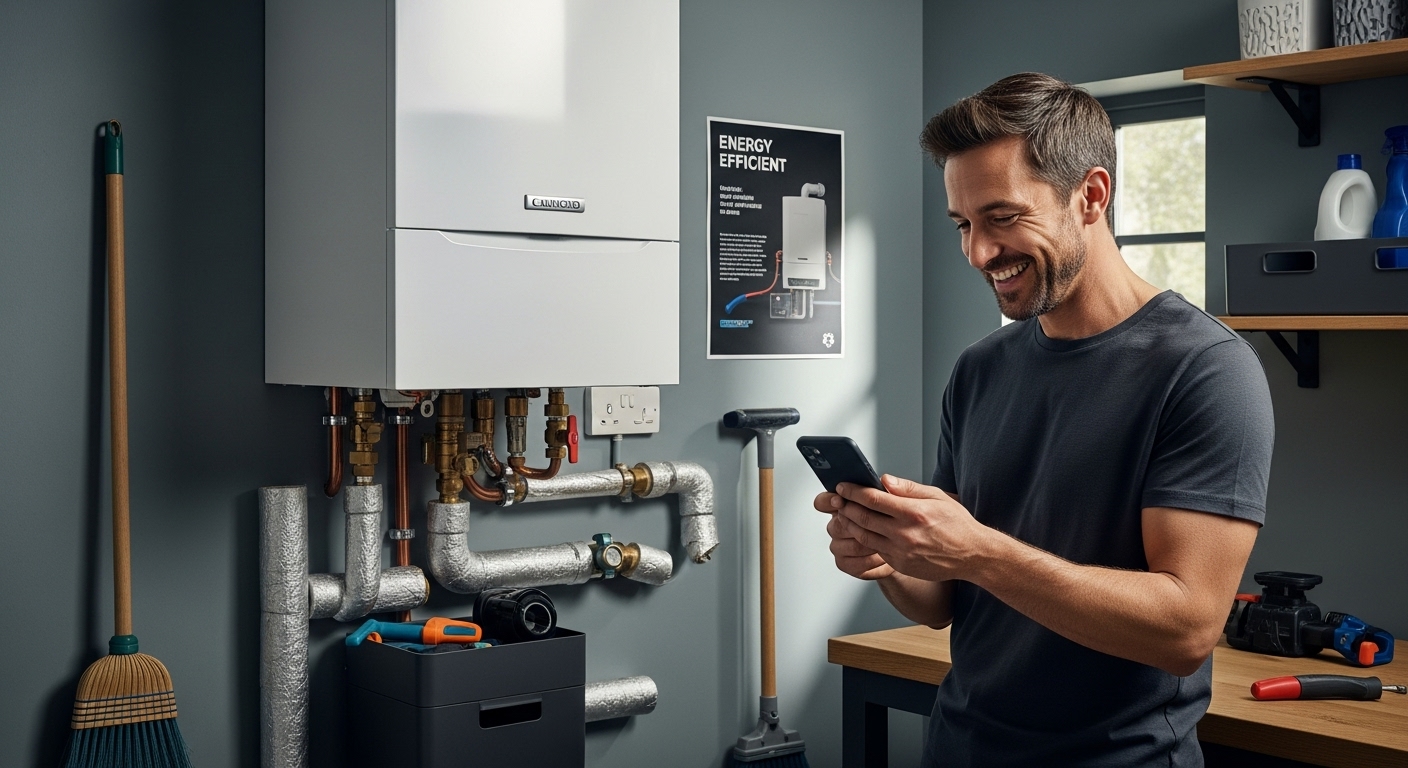
How Do Condensing Boilers Improve Energy Efficiency?
Condensing boilers represent a significant technological leap in home heating efficiency, employing sophisticated mechanisms to capture and utilise heat that would typically be wasted in traditional heating systems. Their advanced design transforms how thermal energy is extracted and deployed, creating unprecedented levels of performance and sustainability.
Heat Recovery Mechanism
The core efficiency improvement in condensing boilers stems from their innovative heat recovery process. Unlike conventional boilers that simply vent hot exhaust gases, these systems capture and reuse latent heat from water vapour within those gases. This means that instead of releasing heat at temperatures around 200300 degrees Celsius, condensing boilers cool exhaust gases to the point where water vapour condenses, releasing additional thermal energy.
According to government energy efficiency statistics, the proportion of homes using condensing boilers has dramatically increased from just 28% in 2001 to 55% by 2023, reflecting their significant efficiency advantages.
Technical Efficiency Characteristics
Condensing boilers achieve superior energy efficiency through several key technical innovations:
- Larger heat exchangers that provide more surface area for heat transfer
- Advanced cooling mechanisms that extract maximum thermal energy
- Intelligent design allowing lower return water temperatures
- Ability to operate at efficiency levels up to 95% compared to traditional boilers
The return water temperature is particularly critical. Traditional boilers typically require return water temperatures around 60-70 degrees Celsius, whereas condensing boilers can effectively operate with return temperatures as low as 30-40 degrees Celsius. This lower temperature range enables more complete heat extraction and significantly reduces energy waste.
Moreover, the technology supports more consistent and uniform heating, reducing energy consumption during startup and maintaining more stable internal temperatures. By capturing heat that would otherwise be lost, condensing boilers transform what was previously considered waste energy into a valuable heating resource, representing a fundamental shift in how we approach home heating efficiency.
What are the Environmental Benefits of Condensing Boilers?
Condensing boilers represent a pivotal technology in addressing environmental challenges, offering substantial ecological advantages that extend well beyond traditional heating systems. Their innovative design not only improves home heating efficiency but also plays a critical role in reducing carbon emissions and supporting broader environmental sustainability goals.
Carbon Emissions Reduction
According to the UK Energy Technology List, installing an energy-efficient condensing boiler can result in annual savings of approximately 6.74 tonnes of carbon dioxide emissions. This significant reduction represents a meaningful contribution to mitigating climate change at the individual household level.
The mechanism behind these emissions reductions lies in the boilers’ ability to capture and reuse heat that would traditionally be wasted. By extracting additional thermal energy from exhaust gases, condensing boilers require less fuel to generate the same amount of heat, directly translating to lower carbon output.
Environmental Performance Characteristics
Condensing boilers demonstrate superior environmental performance through several key attributes:
- Dramatically lower greenhouse gas emissions compared to traditional boilers
- Reduced overall energy consumption
- Enhanced heat recovery mechanisms
- Support for national and international carbon reduction targets
- Compatibility with renewable energy integration strategies
Moreover, these boilers align perfectly with emerging environmental regulations and sustainability frameworks. Their design inherently supports the transition towards more responsible and efficient energy consumption models, making them a critical technology in the broader landscape of environmental conservation.
The environmental benefits extend beyond immediate carbon reductions. By promoting more intelligent energy use, condensing boilers encourage a systemic shift in how we approach home heating. They represent more than just a technological upgrade they are a practical, actionable step towards creating more sustainable living environments and contributing to global efforts to mitigate climate change.
How Do Condensing Boilers Compare to Traditional Heating Systems?
The evolution of home heating technology has dramatically transformed how we approach energy consumption, with condensing boilers representing a significant leap forward from traditional heating systems. These advanced units offer substantial improvements in efficiency, performance, and environmental impact, fundamentally changing the landscape of residential heating.
Efficiency and Performance Differences
According to research from the Centre for Sustainable Energy, upgrading from a G-rated boiler to an A-rated condensing boiler with full heating controls can save around 320 annually on heating bills. This dramatic difference stems from the core technological distinctions between traditional and condensing systems.
Traditional boilers typically operate at efficiency levels around 55-70%, meaning a significant portion of generated heat is lost through exhaust gases. In contrast, condensing boilers can achieve efficiency rates up to 90%, capturing and reusing heat that would otherwise be wasted. This means for every 3 spent on fuel, condensing boilers effectively use 90p for heating and hot water, compared to just 55p in older systems.
Key Comparative Characteristics
The fundamental differences between condensing and traditional heating systems extend beyond mere efficiency metrics:
- Heat recovery mechanism (condensing boilers capture latent heat from exhaust gases)
- Operating temperature ranges
- Carbon emission levels
- Initial installation and long-term operational costs
- Environmental sustainability impact
Traditional boilers typically release exhaust gases at temperatures around 200-300 degrees Celsius, essentially discarding valuable thermal energy. Condensing boilers revolutionize this approach by cooling these gases to the point of water vapour condensation, extracting additional heat that would previously have been vented outside.
Moreover, condensing boilers support more consistent and uniform heating, reducing energy consumption during startup and maintaining more stable internal temperatures. They represent a technological solution that not only reduces energy bills but also contributes meaningfully to reducing household carbon footprints, marking a significant advancement in home heating technology.
Below is a comparison table outlining the key differences between condensing boilers and traditional heating systems, helping homeowners easily understand efficiency, cost, and environmental contrasts.
| Feature/Characteristic | Condensing Boiler | Traditional Boiler |
|---|---|---|
| Typical Efficiency (%) | 90-95 | 55-70 |
| Heat Recovery Mechanism | Captures and reuses heat from exhaust gases | Releases heat in exhaust gases |
| Flue Gas Temperature (°C) | Cooled to 30-40 (to induce condensation) | Released at 200-300 |
| Average Annual Savings (£) | Up to 320 | Minimal savings (older systems) |
| Carbon Emissions | Significantly reduced | Higher due to fuel waste |
| Environmental Impact | Supports sustainability targets | Less environmentally friendly |
| Installation Cost | Slightly higher, offset by long-term savings | Often lower, but less efficient |
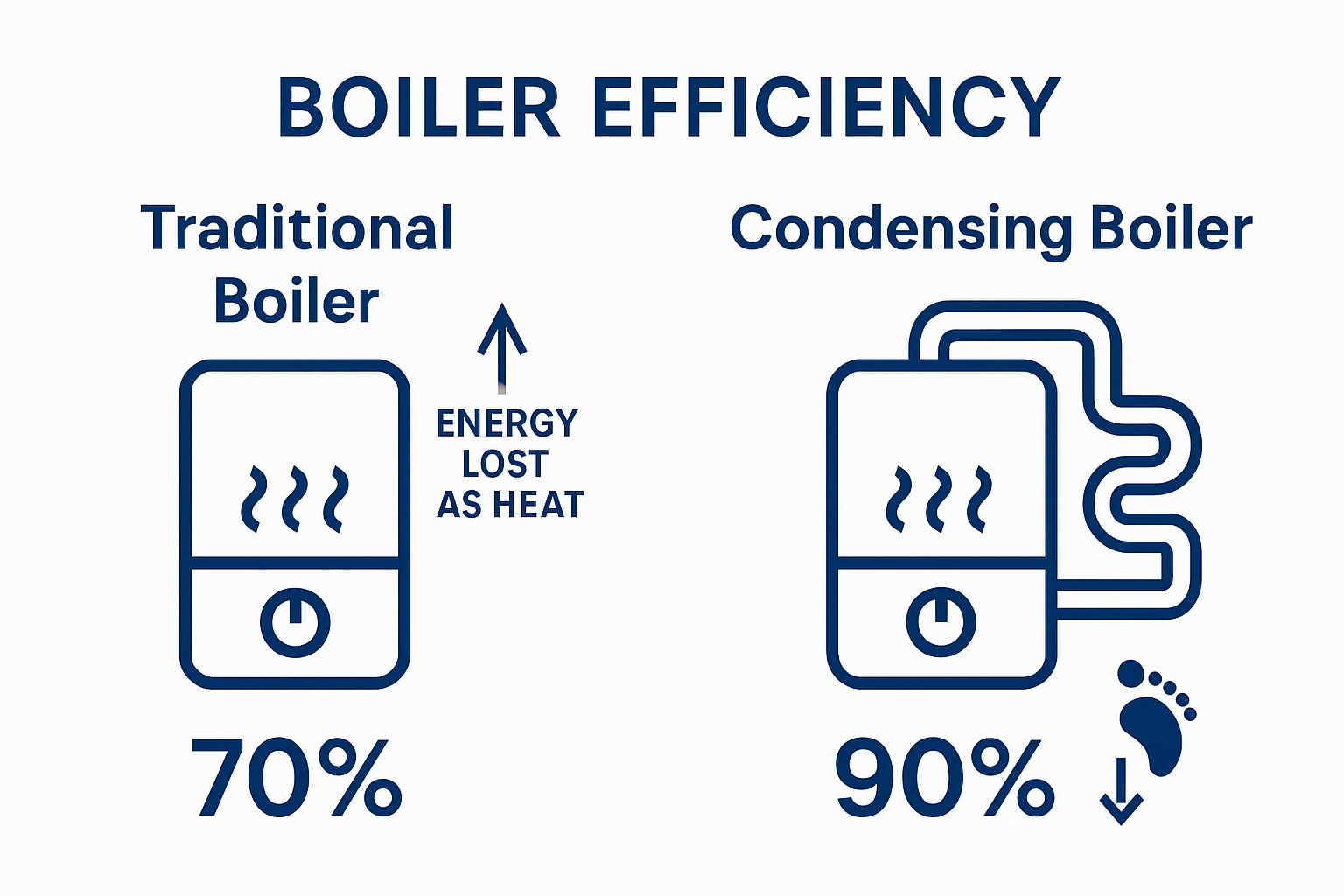
Ready to Experience the Full Advantages of a Condensing Boiler?
Are you tired of wasting energy and seeing high heating bills, even when your home never feels quite warm enough? This article highlights how condensing boilers reclaim heat that traditional systems waste, lowering both your energy costs and carbon emissions. Many homeowners in Edinburgh and Midlothian face outdated systems, inefficient heating, and growing pressure to reduce their carbon footprint. Upgrading to a high-efficiency condensing boiler puts you in control of your comfort and your home’s long-term sustainability.

Now is the perfect time to turn knowledge into action. The team at Thermatek Heating specialises in hassle-free, energy-efficient boiler replacements and comprehensive boiler servicing, delivered by trusted Gas Safe Registered engineers. Take the first step towards a warmer, greener home. Request your free quote or expert consultation today and discover why so many local homeowners rely on Thermatek for the smartest heating solutions.
Frequently Asked Questions
What is a condensing boiler?
A condensing boiler is a highly efficient heating system that captures and reuses heat from exhaust gases, reducing energy waste and enhancing overall energy efficiency compared to traditional boilers.
How do condensing boilers improve energy efficiency?
Condensing boilers utilize an innovative heat recovery mechanism that extracts latent heat from water vapour in exhaust gases, achieving thermal efficiencies of up to 95%, while traditional systems typically operate at 55-70% efficiency.
What are the environmental benefits of using a condensing boiler?
Condensing boilers significantly reduce carbon emissions and energy consumption by recycling heat that would otherwise be lost, contributing to lower greenhouse gas emissions and helping to meet sustainability goals.
How do condensing boilers compare to traditional heating systems?
Condensing boilers outperform traditional heating systems by capturing additional heat from exhaust gases and achieving higher efficiency rates, leading to reduced energy bills and a smaller carbon footprint.
Recommended
Understanding the Annual Gas Safety Certificate
Every year, thousands of landlords across the UK are required to secure an annual gas safety certificate for their properties. You might expect this to be just another bit of paperwork on a never-ending list. But more than 30 people die each year from carbon monoxide poisoning in the UK and improper gas checks can literally turn a home into a danger zone. What surprises most is that this single document is not just about ticking boxes or following the rules. It is a vital piece of evidence that can mean the difference between safety and disaster, protecting lives, saving money, and keeping the law firmly on your side.
Table of Contents
- What Is An Annual Gas Safety Certificate?
- Why Is The Annual Gas Safety Certificate Important?
- How Does The Annual Gas Safety Certificate Work?
- Key Concepts Related To Annual Gas Safety Certificates
- Real-World Implications Of Having An Annual Gas Safety Certificate
Quick Summary
| Takeaway | Explanation |
|---|---|
| Annual gas safety certificates are mandatory for landlords. | Landlords are legally required to conduct annual safety inspections of gas appliances to ensure tenant safety. |
| Gas Safe registered engineers must perform inspections. | Only qualified professionals can issue certificates, ensuring compliance with safety regulations and standards. |
| Certificates are valid for 12 months. | After 12 months, a new inspection is necessary to maintain legal compliance and ensure continued safety. |
| Non-compliance can result in severe penalties. | Failing to maintain certificates can lead to legal actions, fines, and invalidation of property insurance. |
| Certificates document safety compliance and protect owners. | These documents serve as proof of responsible property management, offering legal protection in case of incidents. |
What is an Annual Gas Safety Certificate?
An annual gas safety certificate represents a crucial legal document that confirms the safe operation and maintenance of gas appliances in residential and commercial properties. This official record verifies that all gas installations, equipment, and flues have been professionally inspected and meet stringent safety standards by a qualified Gas Safe registered engineer.
Understanding the Purpose and Legal Requirements
The annual gas safety certificate serves multiple critical functions for property owners and occupants. According to Health and Safety Executive, it is a mandatory legal requirement for landlords to ensure their gas appliances undergo comprehensive safety checks. The primary objectives of this certificate include:
- Protecting residents from potential gas-related hazards
- Verifying the proper functioning of gas equipment
- Identifying and addressing potential safety risks before they escalate
The certificate provides comprehensive documentation that details the condition of all gas installations, highlighting any necessary repairs or potential safety concerns. For landlords and property managers, this document is not just a recommendation but a legal obligation that helps prevent dangerous situations and potential legal liabilities.
Components of a Comprehensive Gas Safety Check
A professional gas safety inspection involves a meticulous examination of all gas-related equipment and systems. During the assessment, a Gas Safe registered engineer will thoroughly evaluate multiple aspects of gas installations. According to Gas Safety Regulations, this typically includes:
- Checking all gas appliances for proper installation and operational safety
- Examining flue systems to ensure correct ventilation and carbon monoxide prevention
- Testing gas pressure and connection integrity
- Inspecting for potential gas leaks or structural vulnerabilities
Property owners receive a detailed report documenting the inspection findings, which must include the engineer’s registration number, the date of inspection, and a description of each appliance and its location.
The following table summarises the main components checked during a comprehensive annual gas safety inspection, clearly outlining the focus of each part of the assessment.
| Inspection Component | Purpose of Check |
|---|---|
| Gas appliances (e.g. boiler, cooker) | Ensure correct installation and operational safety |
| Flue systems | Verify ventilation and carbon monoxide prevention |
| Gas pressure and connections | Test pressure stability and connection integrity |
| Leak and vulnerability inspection | Identify potential gas leaks and structural weaknesses |
This certificate remains valid for 12 months, after which a new inspection must be conducted to maintain compliance and ensure ongoing safety.
Why is the Annual Gas Safety Certificate Important?
The annual gas safety certificate plays a pivotal role in protecting lives, property, and ensuring legal compliance across residential and commercial settings. Its significance extends far beyond a mere administrative requirement, representing a critical safeguard against potential catastrophic risks associated with faulty gas installations.
![]()
Protecting Human Life and Property
Gas appliances, when improperly maintained, can pose severe health and safety risks. Research from the Gas Safety Trust reveals that carbon monoxide poisoning alone accounts for numerous preventable deaths and serious injuries each year. An annual gas safety certificate helps mitigate these risks by:
- Identifying potential gas leaks before they become life-threatening
- Ensuring proper ventilation and combustion in gas appliances
- Detecting early signs of equipment malfunction or degradation
The comprehensive inspection process acts as a preventative measure, systematically checking for potential hazards that could lead to gas leaks, carbon monoxide exposure, or potential explosions. This proactive approach significantly reduces the likelihood of catastrophic incidents that could result in loss of life or extensive property damage.

Legal Compliance and Financial Protection
Beyond safety considerations, the annual gas safety certificate is a critical legal requirement for landlords and property managers. Non-compliance can result in significant legal and financial consequences. Property owners who fail to obtain and maintain current safety certificates may face:
- Substantial financial penalties
- Potential legal prosecution
- Invalidation of property insurance
- Potential prohibition from renting out property
Moreover, the certificate provides documented proof of responsible property management. In the event of an incident, having a current and comprehensive gas safety certificate can protect property owners from potential liability claims. It demonstrates a commitment to tenant safety and adherence to legal standards, offering both peace of mind and legal protection.
Ultimately, the annual gas safety certificate is not just a bureaucratic requirement but a fundamental instrument of public safety, legal compliance, and responsible property management.
How Does the Annual Gas Safety Certificate Work?
The annual gas safety certificate process is a structured and comprehensive approach to ensuring the safe operation of gas appliances and installations. This systematic evaluation involves multiple critical steps designed to identify and mitigate potential safety risks before they can escalate into dangerous situations.
The Inspection Process
A Gas Safe registered engineer conducts the annual safety inspection, which is the cornerstone of the gas safety certificate. According to Health and Safety Executive, this professional follows a detailed protocol to thoroughly examine all gas-related equipment. The inspection typically encompasses:
- A comprehensive visual examination of all gas appliances
- Detailed testing of equipment functionality and safety mechanisms
- Precise measurements of gas pressure and combustion efficiency
- Rigorous checks for potential gas leaks or structural vulnerabilities
The engineer meticulously documents each aspect of the inspection, creating a detailed record that provides a comprehensive snapshot of the gas installation’s condition. This documentation becomes the foundation of the safety certificate, serving as an official record of the system’s safety status.
Documentation and Certification
Following the inspection, the Gas Safe registered engineer compiles a comprehensive report that serves as the official annual gas safety certificate. This document is more than a simple checklist; it represents a professional assessment of potential risks and safety compliance. The certificate must include critical information such as:
- Specific details of each gas appliance examined
- The engineer’s unique Gas Safe registration number
- Precise date of inspection
- Detailed description of any identified issues or required remedial actions
- Confirmation of the appliance’s safe operational status
Property owners receive this crucial document, which remains valid for 12 months. It serves not just as a legal requirement but as a definitive record of the property’s gas safety standards. Landlords must retain these certificates and provide copies to tenants, ensuring transparency and accountability in maintaining gas safety standards.
Key Concepts Related to Annual Gas Safety Certificates
Understanding the nuanced landscape of gas safety certificates requires comprehensive knowledge of several critical legal, technical, and professional considerations. These key concepts form the foundation of responsible gas equipment management and ensure comprehensive safety protocols across residential and commercial properties.
Professional Certification and Qualifications
The cornerstone of a valid gas safety certificate is the involvement of a Gas Safe registered engineer. According to Health and Safety Executive, this professional qualification represents a stringent standard of competence and legal authorization. Gas Safe registered engineers must demonstrate:
- Comprehensive technical knowledge of gas systems
- Up-to-date understanding of safety regulations
- Proven practical skills in gas appliance inspection
- Current professional accreditation and ongoing training
Only engineers listed on the official Gas Safe Register can legally conduct annual gas safety inspections and issue authoritative safety certificates. This requirement ensures that only qualified professionals assess potentially hazardous gas installations, maintaining the highest standards of technical expertise and safety compliance.
Legal Responsibilities and Scope of Coverage
The annual gas safety certificate encompasses a comprehensive range of legal responsibilities for property owners and managers. These obligations extend beyond simple documentation and require proactive safety management. Key legal considerations include:
- Mandatory annual inspections for all gas appliances and flues
- Providing tenants with a copy of the safety certificate within specified timeframes
- Maintaining detailed records of all inspections and remedial actions
- Addressing any identified safety issues promptly and comprehensively
Property owners must understand that the gas safety certificate is not merely a bureaucratic requirement but a critical legal instrument. It serves as documented evidence of compliance, potentially protecting against liability in the event of gas-related incidents. The certificate must cover all gas appliances provided by the landlord, including boilers, fires, cookers, and other gas-powered equipment installed within the property.
Real-World Implications of Having an Annual Gas Safety Certificate
The annual gas safety certificate extends far beyond a simple bureaucratic requirement, representing a critical instrument of protection for property owners, tenants, and the broader community. Its real-world implications touch multiple aspects of safety, legal compliance, and financial responsibility.
Personal and Property Safety Consequences
The absence of a current gas safety certificate can lead to catastrophic consequences that extend well beyond theoretical risks. Consumer Regulation Review highlights the profound safety implications of neglecting proper gas equipment maintenance. Potential devastating outcomes include:
- Increased risk of carbon monoxide poisoning
- Potential gas explosions or uncontrolled fires
- Long-term health complications from prolonged gas exposure
- Irreversible damage to property infrastructure
These risks are not merely hypothetical. Faulty or uninspected gas installations can create silent, invisible threats that compromise the fundamental safety of residential and commercial environments. The annual gas safety certificate serves as a critical preventative measure, systematically identifying and mitigating potential hazards before they can transform into life-threatening situations.
Legal and Financial Ramifications
Beyond immediate safety concerns, the annual gas safety certificate carries significant legal and financial implications for property owners. Non-compliance can trigger a cascade of serious consequences that extend far beyond potential safety incidents. Property owners who fail to maintain current gas safety certificates may encounter:
This table outlines the potential legal and financial consequences for landlords who fail to comply with annual gas safety certificate obligations, helping clarify the severity of each outcome.
| Consequence | Explanation |
|---|---|
| Financial penalties | Fines imposed by regulatory authorities for non-compliance |
| Legal prosecution | Possible criminal charges due to negligence |
| Invalidation of property insurance | Loss of insurance cover in case of gas-related incidents |
| Liability for injuries or damages | Landlord may be found responsible for tenant harm or property loss |
| Prohibition from renting out property | Authorities may restrict ability to let or lease property |
- Substantial financial penalties from regulatory bodies
- Potential criminal prosecution for negligence
- Invalidation of property insurance policies
- Legal liability for any injuries or damages resulting from gas-related incidents
- Potential prohibition from renting or leasing the property
Moreover, the certificate serves as a crucial legal document that demonstrates responsible property management. In legal proceedings, a comprehensive and current gas safety certificate can provide critical protection, demonstrating that all reasonable precautions were taken to ensure tenant safety and comply with statutory regulations.
Stay Compliant and Safe With Professional Gas Safety Solutions
Are you worried about keeping up with annual gas safety certificate requirements? The risks of missed inspections are significant, from potential gas leaks and carbon monoxide exposure to costly fines and invalidated insurance. You read that an annual gas safety certificate is more than just paperwork. It is your proof of safety, maintained by a qualified Gas Safe registered engineer, and a critical responsibility for every property manager or landlord.

Let the experts at Thermatek handle your compliance with confidence. Our trusted local team is fully certified to carry out precise gas safety checks for Edinburgh and Midlothian properties. We guarantee careful inspections, legitimate certification, and clear documentation to protect both your property and your peace of mind. Discover how our boiler servicing and maintenance options can make yearly compliance effortless. Do not risk safety or legal complications. Visit https://thermatekheating.co.uk now to arrange your annual gas safety check or get a free quote today.
Frequently Asked Questions
What is an annual gas safety certificate?
An annual gas safety certificate is a legal document confirming the safe operation and maintenance of gas appliances within a property, showing that all gas installations have been inspected by a qualified Gas Safe registered engineer.
Why is it important to have an annual gas safety certificate?
The certificate is crucial for ensuring the safety of occupants by identifying potential gas leaks and other hazards, and it is a legal requirement for landlords. Non-compliance can lead to penalties and legal liabilities.
How often do I need to get an annual gas safety check?
An annual gas safety check must be conducted every 12 months to ensure compliance with safety regulations and to provide continued protection against gas-related hazards.
What does a gas safety inspection involve?
A gas safety inspection includes checking all gas appliances for proper installation and safety, examining flue systems, testing gas pressure, and inspecting for potential gas leaks or other safety issues.
Recommended
Understanding Central Heating Upgrades for Homeowners
Central heating upgrades are transforming the way homes stay warm and comfortable across the country. Surprisingly, inefficient heating can account for up to 60 percent of a household’s total energy spend, draining budgets and wasting resources every year. Yet the real surprise is how a single upgrade can do far more than just lower bills—it can slash carbon emissions, enhance comfort, and even boost property value all at once.
Table of Contents
- What Are Central Heating Upgrades?
- Why Central Heating Upgrades Matter For Efficiency
- How Central Heating Systems Work: The Basics
- Key Innovations In Central Heating Technology
- Real-World Impacts Of Upgrading Heating Systems
Quick Summary
| Takeaway | Explanation |
|---|---|
| Upgrade your boiler for efficiency | Swapping an old boiler for a modern model can greatly reduce energy costs and improve heating performance. |
| Install smart thermostats | Intelligent controls can automatically adjust temperatures, optimizing energy use and enhancing comfort tailored to your schedule. |
| Improve insulation for energy savings | Enhancing your home’s insulation helps retain heat, leading to reduced energy consumption and lower bills. |
| Consider renewable energy options | Integrating technologies like heat pumps or solar heating can provide sustainable heating solutions and lower carbon emissions. |
| Evaluate system efficiency regularly | Regular assessments ensure your heating system adapts to needs, maximising comfort while minimising energy waste. |
What Are Central Heating Upgrades?
Central heating upgrades represent strategic improvements to a home’s heating infrastructure designed to enhance energy efficiency, reduce utility costs, and improve overall thermal comfort. These modifications range from simple component replacements to comprehensive system transformations that modernise how heat is generated, distributed, and controlled within residential spaces.
Understanding the Core Concept
At its fundamental level, a central heating upgrade involves enhancing or replacing elements of your home’s existing heating system. This could mean upgrading an outdated boiler, installing more efficient radiators, implementing smart thermostatic controls, or transitioning to renewable energy technologies. The primary objectives are to reduce energy consumption, lower carbon emissions, and create a more comfortable living environment.
According to government energy efficiency research, homeowners can significantly reduce their energy expenditure through strategic heating system improvements. These upgrades are not merely about replacing old equipment but represent a holistic approach to home energy management.
Types of Central Heating Upgrades
Homeowners have multiple pathways for central heating upgrades, each offering distinct benefits:
- Boiler Replacement: Swapping an old, inefficient boiler for a modern condensing model that captures waste heat
- Smart Thermostat Installation: Adding intelligent temperature control systems that learn household patterns
- Insulation Improvements: Enhancing wall, loft, and floor insulation to retain heat more effectively
- Renewable Technology Integration: Incorporating heat pumps or solar thermal systems for sustainable heating solutions
These upgrades not only improve immediate comfort but also contribute to long-term environmental sustainability and potential property value enhancement.
Below is a table summarising the main types of central heating upgrades discussed, along with their key benefits and primary focus areas.
| Upgrade Type | Key Benefit | Primary Focus |
|---|---|---|
| Boiler Replacement | Improves efficiency, lowers costs | Heat generation |
| Smart Thermostat Installation | Optimises energy use, enhances comfort | Temperature control |
| Insulation Improvements | Retains heat, reduces energy loss | Heat retention |
| Renewable Technology Integration | Provides sustainable heating, cuts carbon emissions | Energy source sustainability |
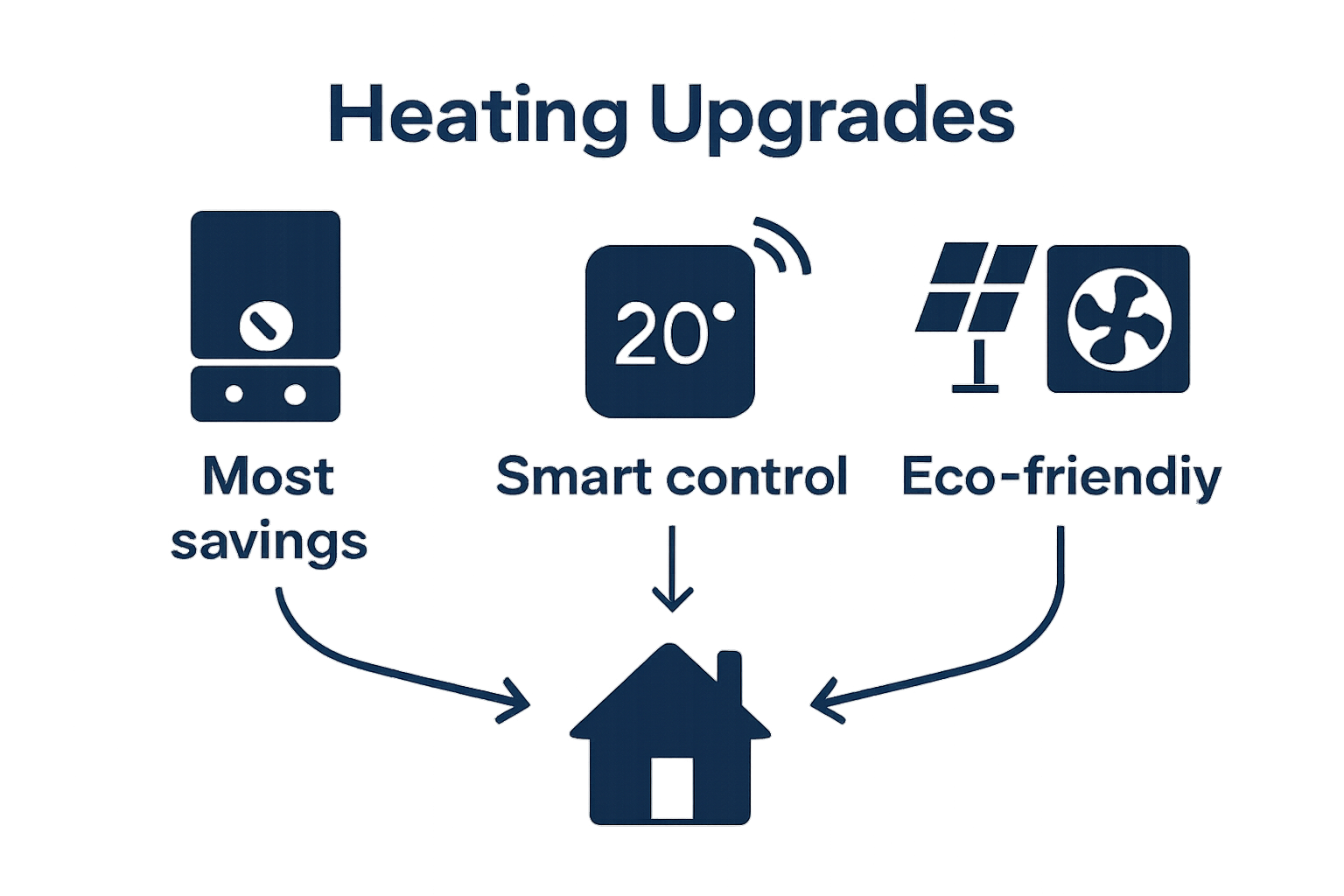 The key is selecting upgrades tailored to your specific home configuration, energy consumption patterns, and budgetary constraints.
The key is selecting upgrades tailored to your specific home configuration, energy consumption patterns, and budgetary constraints.
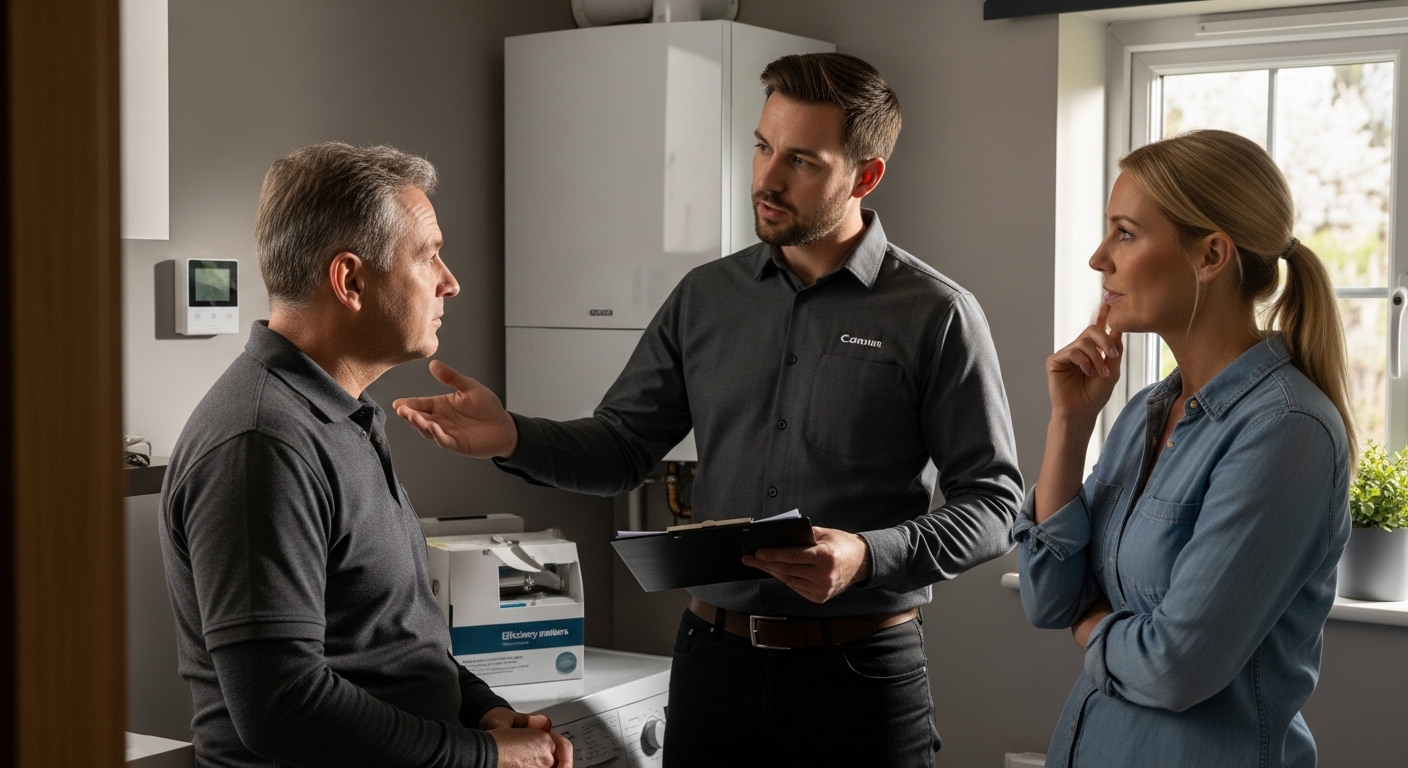
Why Central Heating Upgrades Matter for Efficiency
Central heating efficiency is not just a technical concept but a critical factor in reducing energy consumption, minimising environmental impact, and managing household expenses. By understanding the intricate relationship between heating systems and overall energy performance, homeowners can make informed decisions that deliver substantial long-term benefits.
Economic and Environmental Impact
Modern central heating upgrades represent more than mere technological improvements. They are strategic investments that directly influence household economics and ecological sustainability. Inefficient heating systems can consume up to 60% of a home’s total energy budget, making them prime targets for performance optimization.
According to government energy efficiency research, strategic heating system improvements can generate significant savings and reduce carbon footprints. These upgrades transform heating from a passive utility into an actively managed resource.
Key Efficiency Considerations
Homeowners should evaluate central heating efficiency through multiple critical lenses:
- Energy Consumption: Measuring the total energy required to maintain comfortable indoor temperatures
- Heat Distribution: Assessing how effectively warmth is spread throughout living spaces
- System Responsiveness: Understanding how quickly heating systems adapt to changing temperature requirements
- Carbon Emissions: Calculating the environmental impact of heating technologies
The goal of central heating upgrades extends beyond immediate comfort. By implementing intelligent design and advanced technologies, homeowners can create heating systems that are responsive, economical, and environmentally conscious. Smart upgrades not only reduce monthly utility expenses but also contribute to broader sustainability objectives, making them a win-win solution for both household budgets and global environmental challenges.
How Central Heating Systems Work: The Basics
Central heating systems are sophisticated networks designed to distribute warmth consistently throughout residential spaces. These systems transform energy into heat through a carefully orchestrated process involving multiple interconnected components that work seamlessly to maintain comfortable indoor temperatures.
Core Components and Energy Transformation
At the heart of a central heating system lies the boiler, which serves as the primary heat generator. Modern boilers convert fuel such as gas, oil, or electricity into thermal energy, creating hot water or steam that circulates through a network of pipes and radiators. This process transforms potential energy into a practical, controllable heating solution for homes.
According to research from the City of York Council, the fundamental mechanism involves heating water in the boiler and then distributing it through radiators positioned strategically throughout the property. The temperature and distribution are carefully managed to ensure optimal comfort and energy efficiency.
System Control and Temperature Management
Effective central heating relies on sophisticated control mechanisms that enable precise temperature regulation:
- Room Thermostats: Monitor and maintain desired indoor temperatures
- Thermostatic Radiator Valves: Allow individual room temperature adjustments
- Programmers: Enable scheduled heating periods to match household routines
- Smart Controls: Provide remote temperature management and energy usage insights
These intelligent systems transform central heating from a simple warmth provider into a responsive, adaptive infrastructure that can learn and adjust to specific household requirements.
This table compares essential components and control features of central heating systems, providing a clear overview of their roles and contributions to home comfort and efficiency.
| Component/Control | Function | Contribution to Efficiency |
|---|---|---|
| Boiler | Generates heat from gas, oil, or electricity | Key to overall system performance |
| Radiators | Distribute heat throughout living spaces | Ensure even heat distribution |
| Room Thermostat | Monitors and manages desired indoor temperature | Prevents overheating and waste |
| Thermostatic Radiator Valves | Enable individual room temperature adjustments | Allows zoned heating and savings |
| Programmers | Schedule heating periods to fit routines | Reduces unnecessary operation |
| Smart Controls | Offer remote and adaptive system management | Maximises responsiveness and savings |
By understanding how these components interact, homeowners can optimize their heating systems for maximum comfort and minimal energy waste.
Key Innovations in Central Heating Technology
Central heating technology has undergone remarkable transformations, driven by the urgent need for energy efficiency, reduced carbon emissions, and enhanced user comfort. These innovations represent a significant leap forward in how we conceptualize, design, and implement residential heating solutions.
Smart Technology Integration
Intelligent heating systems have revolutionized temperature management, moving beyond traditional mechanical controls to create adaptive, responsive environments. Modern technologies enable homeowners to monitor, control, and optimize their heating remotely through smartphone applications and sophisticated network connections. These smart systems learn household patterns, automatically adjusting temperatures to minimize energy waste while maintaining optimal comfort levels.
According to government energy technology research, technological innovations are crucial in reducing residential energy consumption and supporting national decarbonization objectives.
Renewable Energy Convergence
The latest central heating technologies are increasingly integrating renewable energy sources, fundamentally changing how heat is generated and distributed. Key developments include:
Heat Pump Technology: Extracting thermal energy from air, ground, or water sources
Solar Thermal Systems: Using solar collectors to preheat water for heating
Hybrid Heating Solutions: Combining traditional boilers with renewable technologies for maximum efficiency
These innovations represent more than technological upgrades. They signify a profound shift towards sustainable, environmentally conscious heating strategies that balance performance, cost-effectiveness, and ecological responsibility. By embracing these cutting-edge technologies, homeowners can significantly reduce their carbon footprint while enjoying superior heating comfort.
Real-World Impacts of Upgrading Heating Systems
Heating system upgrades extend far beyond technical improvements, delivering tangible benefits that transform homeowners’ daily experiences and broader environmental landscapes. These upgrades represent strategic investments with multifaceted advantages that impact personal comfort, financial sustainability, and ecological responsibility.
Economic Transformation
Upgrading central heating systems delivers substantial economic advantages, dramatically reducing long-term energy expenditures. Homeowners can experience significant cost reductions through more efficient technology, with modern systems potentially decreasing energy consumption by up to 40%. The financial implications are profound, translating into hundreds of pounds saved annually on utility bills.
According to government energy efficiency research, strategic heating system improvements generate measurable economic benefits while supporting national energy efficiency objectives.
Environmental and Social Implications
Modern heating system upgrades contribute meaningfully to broader environmental goals, offering multiple interconnected advantages:
- Carbon Emission Reduction: Lowering household carbon footprints through advanced technologies
- Energy Conservation: Minimizing unnecessary energy consumption
- Resource Efficiency: Utilizing renewable and sustainable heating technologies
- Climate Change Mitigation: Supporting national decarbonization strategies
These upgrades represent more than individual choices. They constitute collective action towards creating more sustainable, environmentally responsible communities. By investing in advanced heating technologies, homeowners become active participants in addressing critical environmental challenges, demonstrating how personal infrastructure decisions can generate meaningful global impact.
Ready for a Warmer, More Efficient Home?
Are you tired of high energy bills and unpredictable heating? If the article “Understanding Central Heating Upgrades for Homeowners” made you aware of inefficient systems, wasted money, or outdated controls, now is the perfect time to take action. At Thermatek, we specialise in bringing advanced technology and personal expertise to every home across Edinburgh and Midlothian. You deserve the peace of mind that comes from a fully optimised, energy-efficient heating solution.

Imagine a home that stays consistently comfortable, with every pound spent on heating working harder for you. Our central heating upgrades include smart thermostats, boiler replacements, renewable solutions and professional maintenance tailored to your needs. Make the smart move today and contact our Gas Safe Registered engineers for your free quote or expert advice. Visit Thermatek Heating now and experience the transformation.
Frequently Asked Questions
What are the benefits of upgrading my central heating system?
Upgrading your central heating system can enhance energy efficiency, lower utility costs, improve thermal comfort, and reduce carbon emissions, leading to a more sustainable home environment.
How do I know if my boiler needs to be replaced?
Signs that your boiler may need replacement include frequent breakdowns, rising energy bills, inconsistent heating, and if your boiler is older than 10-15 years, as newer models are generally more efficient.
What types of upgrades can I make to my heating system?
You can consider various upgrades, such as replacing your old boiler with a modern condensing model, installing smart thermostats, improving insulation, or integrating renewable technologies like heat pumps or solar thermal systems.
How can smart thermostats improve my heating efficiency?
Smart thermostats learn household patterns, allowing for precise temperature control based on your schedule. This leads to reduced energy waste and more effective heating, ultimately saving you money on energy bills.
Recommended
Understanding Building Regulations for Boilers
Every modern home relies on a boiler to stay warm and safe, but the rules governing their installation are far from basic. Some people are surprised to learn that boiler regulations directly influence carbon emissions and are mandatory for every new installation, with penalties for non-compliance. Many assume these rules are mere paperwork, yet the true impact reaches much further, affecting not just safety but how future-ready your heating system can be.
Table of Contents
- What Are Building Regulations For Boilers?
- Why Building Regulations Matter For Boiler Safety
- How Building Regulations Impact Heating Systems
- Key Concepts Of Boiler Compliance And Standards
Quick Summary
| Takeaway | Explanation |
|---|---|
| Building regulations ensure boiler safety | These regulations protect lives and property by enforcing stringent safety standards for boiler installations. |
| Compliance with standards is mandatory | Installers must adhere to specific technical requirements and obtain necessary certifications to ensure safe installations. |
| Regulations promote energy efficiency | Building regulations mandate minimum performance levels, encouraging the development of advanced, energy-efficient heating solutions. |
| Professional installation is crucial | Only qualified professionals should install boilers, ensuring compliance with regulations and reducing safety risks. |
| Ongoing advancements in technology | Regulations drive innovation, compelling manufacturers to create sustainable, low-carbon heating technologies for the future. |
What are Building Regulations for Boilers?
Building regulations for boilers represent a crucial framework of statutory requirements designed to ensure safety, efficiency, and environmental standards in heating system installations across residential and commercial properties. These comprehensive guidelines establish precise technical specifications that all boiler installations must meet, protecting homeowners and occupants from potential risks associated with improper heating system setup.
The Purpose of Building Regulations
Building regulations for boilers serve multiple critical objectives. They are not merely bureaucratic rules but comprehensive safety protocols that protect both property owners and residents. The primary goals include:
- Ensuring the safe installation of heating equipment
- Preventing potential carbon monoxide risks
- Maintaining minimum energy efficiency standards
- Protecting structural integrity during installation
- Reducing overall carbon emissions
These regulations, established by governmental bodies, provide a standardised approach to boiler installations that prioritises public safety and environmental responsibility.
The table below summarises the core objectives of boiler building regulations and their significance for homeowners, landlords, and the environment.
| Objective | Significance |
|---|---|
| Safe installation of heating equipment | Prevents accidents, injury, or property damage |
| Prevent carbon monoxide risks | Reduces exposure to a life-threatening and odourless gas |
| Maintain minimum energy efficiency | Promotes cost savings and lowers environmental impact |
| Protect structural integrity | Ensures building safety during installation processes |
| Reduce overall carbon emissions | Contributes to climate change mitigation and cleaner air |
![]() Approved Document J specifically outlines the technical requirements for combustion appliances, including detailed guidance on boiler installations.
Approved Document J specifically outlines the technical requirements for combustion appliances, including detailed guidance on boiler installations.
Compliance and Technical Requirements
Compliance with building regulations involves meeting specific technical standards that cover various aspects of boiler installation. These include precise requirements for:
- Proper ventilation and air supply
- Safe flue and combustion product discharge
- Appropriate insulation and heat retention
- Electrical and gas connection specifications
- Energy efficiency performance metrics
Professional installers must adhere to these stringent guidelines, which often require certification from recognised competent person schemes.
The following table presents key technical requirements that must be met for boiler installations, clarifying their purpose and impact for property owners.
| Requirement | Purpose | Impact on Safety/Efficiency |
|---|---|---|
| Proper ventilation and air supply | Ensures safe combustion | Prevents gas build-up and hazards |
| Safe flue and combustion product discharge | Removes harmful gases from the property | Minimises carbon monoxide risks |
| Appropriate insulation and heat retention | Reduces heat loss | Increases energy efficiency |
| Electrical and gas connection specifications | Meets national installation safety standards | Prevents leaks, shocks, or fires |
| Energy efficiency performance metrics | Sets minimum operational efficiency | Promotes cost-effective heating |
Ultimately, building regulations for boilers represent a critical safeguard, ensuring that heating systems are installed safely, efficiently, and in compliance with national standards. By establishing clear technical requirements, these regulations protect both individual properties and broader environmental interests.
Why Building Regulations Matter for Boiler Safety
Building regulations play a fundamental role in safeguarding lives and properties by establishing stringent safety standards for boiler installations. These regulations are not merely bureaucratic paperwork but a critical protective mechanism that mitigates potential hazards associated with heating systems.
Preventing Life-Threatening Risks
Boiler installations carry significant inherent risks that can have catastrophic consequences if not properly managed. Improper installation or faulty equipment can lead to severe safety issues such as:
- Carbon monoxide poisoning
- Gas leaks
- Potential explosions
- Structural damage
- Electrical malfunctions
According to research from the Gas Safe Register, inadequate gas work and boiler installations pose substantial risks to household safety. The regulations provide a comprehensive framework to minimise these potential dangers.
Technical Standards and Professional Accountability
Building regulations enforce rigorous technical standards that demand professional competence and accountability. These standards ensure that only qualified professionals can undertake boiler installations, creating multiple layers of safety verification. Key accountability measures include:
- Mandatory certification for installers
- Comprehensive technical inspection protocols
- Regular safety assessments
- Mandatory documentation and reporting
- Compliance verification by local authorities
For landlords managing rental properties, understanding these safety requirements is crucial. Our landlord gas safety services provide comprehensive guidance on meeting these critical regulatory standards.
Ultimately, building regulations for boiler safety represent a proactive approach to protecting households. By establishing clear, enforceable standards, these regulations significantly reduce the risks associated with heating system installations, ensuring both immediate safety and long-term peace of mind for property owners and occupants.
How Building Regulations Impact Heating Systems
Building regulations fundamentally transform how heating systems are designed, installed, and operated, creating a comprehensive framework that influences technological innovation, energy efficiency, and environmental sustainability. These regulations go beyond simple technical specifications, acting as a strategic mechanism to drive meaningful improvements in residential and commercial heating infrastructure.
Energy Efficiency and Performance Standards
Building regulations establish strict performance metrics that compel manufacturers and installers to develop increasingly sophisticated heating technologies. By mandating minimum efficiency levels, these regulations encourage the development of advanced heating solutions that consume less energy and produce fewer carbon emissions. Key performance requirements include:
- Minimum thermal efficiency ratings
- Maximum permitted carbon emission levels
- Enhanced insulation and heat retention standards
- Sophisticated modulation and temperature control capabilities
- Compatibility with renewable energy integration
Research from the UK government indicates ongoing efforts to enhance boiler standards, with proposed requirements such as making new gas boilers ‘hydrogen-ready’ from 2026, demonstrating the dynamic nature of these regulations.
Technological Innovation and System Transformation
Building regulations act as a powerful catalyst for technological transformation in heating systems. They create a regulatory environment that:
- Incentivises research and development
- Pushes manufacturers towards more sustainable solutions
- Accelerates the transition to low-carbon heating technologies
- Establishes clear pathways for future energy system adaptations
- Promotes consumer awareness about energy-efficient technologies
For homeowners exploring advanced heating solutions, our heat pump installation services represent a forward-thinking approach aligned with these evolving regulatory standards.
Ultimately, building regulations are not static documents but dynamic frameworks that continuously reshape heating system design. By setting progressively ambitious standards, these regulations drive systemic improvements in energy efficiency, technological innovation, and environmental sustainability, ensuring that heating systems become increasingly intelligent, responsive, and eco-friendly.
Key Concepts of Boiler Compliance and Standards
Boiler compliance and standards represent a sophisticated framework of technical requirements designed to ensure the safe, efficient, and environmentally responsible operation of heating systems. These comprehensive guidelines encompass multiple layers of regulatory oversight, establishing precise benchmarks for installation, performance, and ongoing maintenance.
Technical Certification and Installation Requirements
Technical certification forms the cornerstone of boiler compliance, establishing rigorous criteria that professionals must meet to legally install and service heating systems. These requirements demand:
- Mandatory professional qualifications
- Comprehensive safety training certification
- Detailed knowledge of current building regulations
- Proven competence in specific installation techniques
- Regular professional recertification
According to Approved Document J, these standards ensure that only qualified professionals can undertake complex heating system installations, significantly reducing potential safety risks.
Performance and Efficiency Measurement Standards
Performance standards establish precise metrics for measuring boiler efficiency, safety, and environmental impact. These standards evaluate critical aspects such as:
- Thermal energy conversion rates
- Carbon emission levels
- Heat output consistency
- Energy consumption metrics
- Operational reliability
Modern compliance frameworks go beyond basic functionality, demanding that heating systems demonstrate sophisticated technological capabilities. Our boiler installation quote service helps homeowners navigate these complex technical requirements, ensuring complete regulatory adherence.
Ultimately, boiler compliance and standards represent a dynamic regulatory ecosystem that continuously evolves. By establishing clear, measurable guidelines, these standards protect consumers, drive technological innovation, and contribute to broader environmental sustainability goals, transforming heating systems from simple utility appliances into intelligent, responsible energy solutions.
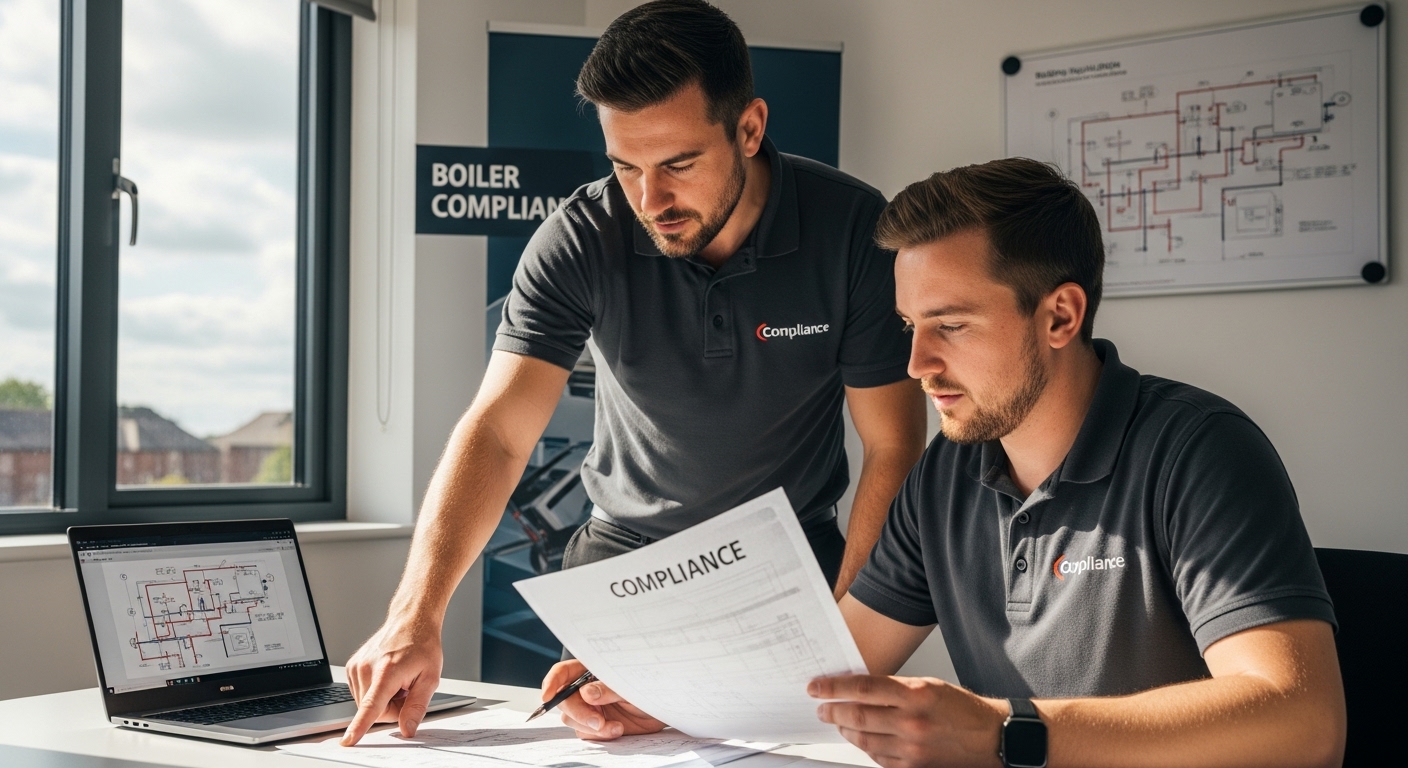
Take the Stress Out of Boiler Compliance in Edinburgh and Midlothian
Struggling to make sense of complex building regulations for boilers? If your top concerns are safety, meeting legal requirements, and avoiding risky installations, you are not alone. Many homeowners and landlords find navigating technical standards, certification, and energy efficiency a real challenge. The article highlights how crucial it is to get every detail right for both peace of mind and property safety. That is why trusting a qualified team becomes essential.

Choose Thermatek, your local experts in safe boiler installation and compliance. Every service is carried out by Gas Safe Registered engineers who know the latest building regulations inside out. From helping you understand intricate requirements to providing reliable boiler replacement and installation or landlord gas safety checks, you get support at every step. Discover the comfort and security of a professionally installed system by visiting our main website today. Act now to secure an energy-efficient, fully compliant heating solution that lasts.
Frequently Asked Questions
What are building regulations for boilers?
Building regulations for boilers are a set of statutory requirements that ensure safety, efficiency, and environmental standards in the installation of heating systems. They establish technical specifications that protect homeowners and occupants from risks associated with improper boiler setups.
Why are building regulations important for boiler safety?
Building regulations are essential for boiler safety as they mitigate life-threatening risks such as carbon monoxide poisoning, gas leaks, and potential explosions. They create a framework of safety protocols to ensure that boiler installations are completed correctly and safely.
What technical requirements must be met for boiler installations?
Boiler installations must satisfy several technical requirements, including proper ventilation, safe flue discharge, adequate insulation, and compliance with specific energy efficiency performance metrics. These standards ensure that heating systems operate safely and effectively.
How do building regulations impact the efficiency of heating systems?
Building regulations contribute to the efficiency of heating systems by enforcing performance standards that require technological advancements in boiler design. These regulations encourage the development of energy-efficient solutions, reducing carbon emissions and improving overall energy consumption.
Recommended
- New Boiler Installation & Replacement In Edinburgh - Thermatek Heating
- Annual Boiler Servicing In Edinburgh - Thermatek Heating
- Boiler Installation Quote - Thermatek Heating
- Boiler Repair In Edinburgh | 24/7 Emergency Call Out - Thermatek Heating
Master the Boiler Replacement Process with Ease
Boiler replacement is often seen as a daunting project, and with good reason. A poorly performing system can waste a surprising amount of money each year, with older boilers running at just 60% efficiency compared to over 90% for modern models. Most people focus on choosing a shiny new unit, but few realise that the secret to a smooth, cost-effective switch lies in the careful steps you take before the installer even arrives.
Table of Contents
- Step 1: Assess Your Current Boiler And Heating Needs
- Step 2: Choose The Right Replacement Boiler Model
- Step 3: Prepare Your Home For Installation
- Step 4: Remove The Old Boiler Safely
- Step 5: Install The New Boiler And Connect Utilities
- Step 6: Test And Verify Boiler Functionality
Quick Summary
| Key Point | Explanation |
|---|---|
| 1. Assess your current boiler’s condition | Evaluate age, efficiency, and performance indicators to determine if replacement is necessary. |
| 2. Choose the right boiler model | Select a boiler type that fits your household’s heating needs and space requirements while considering efficiency ratings. |
| 3. Prepare your home for installation | Clear the installation area, check existing pipework, and protect your home’s interior to ensure smooth installation. |
| 4. Ensure safe removal of the old boiler | Follow proper disconnection procedures and professional guidelines to safely remove the old boiler without hazards. |
| 5. Test the new boiler comprehensively | Conduct thorough testing to verify proper functionality, safety, and efficiency of the newly installed boiler. |
Step 1: Assess Your Current Boiler and Heating Needs
The first critical phase of the boiler replacement process involves a comprehensive assessment of your current heating system. Understanding the precise condition and performance of your existing boiler will determine whether replacement is necessary and help you make informed decisions about future heating solutions.
Begin by examining your current boiler’s age, efficiency, and operational history. Most boilers have a typical lifespan of 10 to 15 years. If your system is approaching or has exceeded this range, it likely operates at reduced efficiency and consumes more energy than modern alternatives. Pay close attention to warning signs such as inconsistent heating, unusual noises, frequent breakdowns, or rising energy bills.
Carefully inspect your boiler for visible signs of wear or damage. Look for rust, corrosion, water leaks, or carbon scoring around the combustion area. These indicators suggest potential internal degradation that could compromise system safety and performance. A professional assessment from a Gas Safe Registered engineer provides the most accurate evaluation of your boiler’s condition.
Your home’s specific heating requirements also play a crucial role in determining the appropriate replacement. Consider factors like property size, insulation quality, number of radiators, and your household’s hot water consumption. These elements directly influence the type and capacity of boiler most suitable for your needs. For instance, a large family home will require a different system compared to a compact apartment.
Our comprehensive guide on boiler installation can help you understand the nuanced considerations involved in selecting the right heating solution. Modern condensing boilers offer significantly improved energy efficiency, potentially reducing your annual heating costs and carbon footprint.
Documenting your current system’s specifications becomes essential. Gather information about your existing boiler’s make, model, output rating, and fuel type. This data will prove invaluable when consulting with heating professionals and obtaining replacement quotes. Take photographs of your current installation and note down any specific installation constraints or unique requirements in your property.
Successful completion of this assessment phase means you have a clear understanding of your current heating system’s limitations, your household’s specific requirements, and the potential benefits of a new boiler installation.
Step 2: Choose the Right Replacement Boiler Model
Selecting the appropriate boiler model represents a pivotal decision in your replacement journey, directly impacting your home’s comfort, energy efficiency, and long term running costs. The right choice requires carefully balancing your household’s specific heating and hot water requirements with technological capabilities and budget constraints.
Modern boiler technology offers three primary configurations: combi boilers, system boilers, and regular boilers. Combi boilers provide instant hot water without requiring a separate cylinder, making them ideal for smaller properties with limited space. System boilers integrate the heating and hot water components within the unit, connecting directly to a storage cylinder. Regular boilers work best in larger homes with multiple bathrooms, featuring separate hot water cylinders and cold water storage tanks.
Consider your household’s specific characteristics when making this selection. Single occupants or couples in compact apartments might find combi boilers most suitable, while larger families with simultaneous hot water demands could benefit from system or regular boiler configurations. Pay close attention to factors like available installation space, existing pipework, and potential future changes in household composition.
To help you decide which type of boiler best suits your home, the table below compares the three main options discussed in the article.
| Boiler Type | Suitable For | Key Features | Efficiency |
|---|---|---|---|
| Combi Boiler | Small homes, flats, couples | Instant hot water, no separate cylinder required | 90–95% |
| System Boiler | Medium homes, families | Requires hot water cylinder, good for simultaneous use | 90–95% |
| Regular Boiler | Large homes, multiple bathrooms | Needs both hot and cold water tanks, best for high demands | 90–95% |
Energy efficiency ratings play a crucial role in your selection process. Modern condensing boilers typically achieve efficiency ratings between 90% and 95%, significantly reducing energy consumption compared to older models. Look for boilers with high seasonal efficiency ratings, which indicate performance across varying temperature conditions. The higher the rating, the lower your potential energy bills and carbon emissions.
Our boiler installation quote service can help you navigate the complexities of selecting the most appropriate model for your specific requirements. Professional heating engineers can provide tailored recommendations based on an in depth assessment of your property.
Budget considerations extend beyond the initial purchase price. Factor in installation costs, potential system modifications, and projected long term running expenses. While high efficiency models might present higher upfront investments, they frequently deliver substantial savings through reduced energy consumption. Warranty coverage and manufacturer reputation should also influence your decision, ensuring reliability and comprehensive support throughout your boiler’s operational lifespan.
Successful completion of this step means you have a clear, informed understanding of the boiler model best suited to your home’s unique heating requirements, setting the foundation for an efficient and cost effective heating solution.
Step 3: Prepare Your Home for Installation
Preparing your home for boiler installation represents a crucial phase that ensures a smooth, efficient replacement process. This preparatory stage involves multiple important considerations that can significantly impact the overall success of your heating system upgrade.
Begin by clearing substantial workspace around your existing boiler location. Professional installers require unobstructed access to remove the old unit and position the new boiler. Measure and create a clear zone of at least two metres surrounding the installation area, removing furniture, decorative items, and any potential obstacles. If your boiler is located in a cupboard or tight space, consider temporarily relocating stored items to facilitate easy equipment movement.
Carefully review your property’s current pipework and radiator configuration. Some boiler replacements might necessitate modifications to existing plumbing systems. Inspect visible pipework for signs of wear, corrosion, or potential leakage. Old pipework may require upgrading to ensure compatibility with your new heating system. Professional installers will conduct a comprehensive assessment, but identifying potential issues beforehand can streamline the installation process.
Protect your home’s interior surfaces by laying down protective coverings such as dust sheets or cardboard. Installation work can generate debris, dust, and potential minor scratches. Cover flooring, nearby furniture, and create a clear path for installers to move equipment through your property. This preparation minimises potential damage and demonstrates consideration for the installation team.
Use this checklist before installation day to ensure your home is fully prepared for a smooth boiler replacement.
| Preparation Task | Details/Guidance | Completed (Yes/No) |
|---|---|---|
| Clear installation area | Remove obstacles and create at least two metres of workspace | |
| Review pipework and radiators | Inspect for corrosion or leaks; identify if upgrades are needed | |
| Protect surfaces and create clear pathways | Use dust sheets or cardboard to cover floors and furniture | |
| Gather documentation | Collect warranties, service records, and technical specifications | |
| Arrange for attendance and pet safety | Ensure someone is present and pets are kept clear of the area | |
| Check and ensure good ventilation | Open windows and provide airflow during and after installation |
Our annual boiler servicing experts recommend gathering all relevant documentation related to your current and new heating systems. This includes manufacturer warranties, previous service records, and technical specifications. Having these documents readily available helps installers understand your property’s specific heating history and requirements.
Consider practical logistics surrounding the installation day. Arrange for someone to be present throughout the entire process, typically requiring a full working day. Ensure pets are safely contained or removed from the installation area to prevent disruption and potential safety risks. If you have specific scheduling constraints or access requirements, communicate these with your installation team in advance.
Ensure your home has adequate ventilation during and after installation. New boiler systems might produce dust and temporary odours during setup. Open windows in the installation area to maintain air circulation and create a comfortable working environment for the installation professionals.
Successful completion of this preparation phase means your home is fully ready for a professional, efficient boiler replacement, minimising potential complications and ensuring a smooth transition to your new heating system.
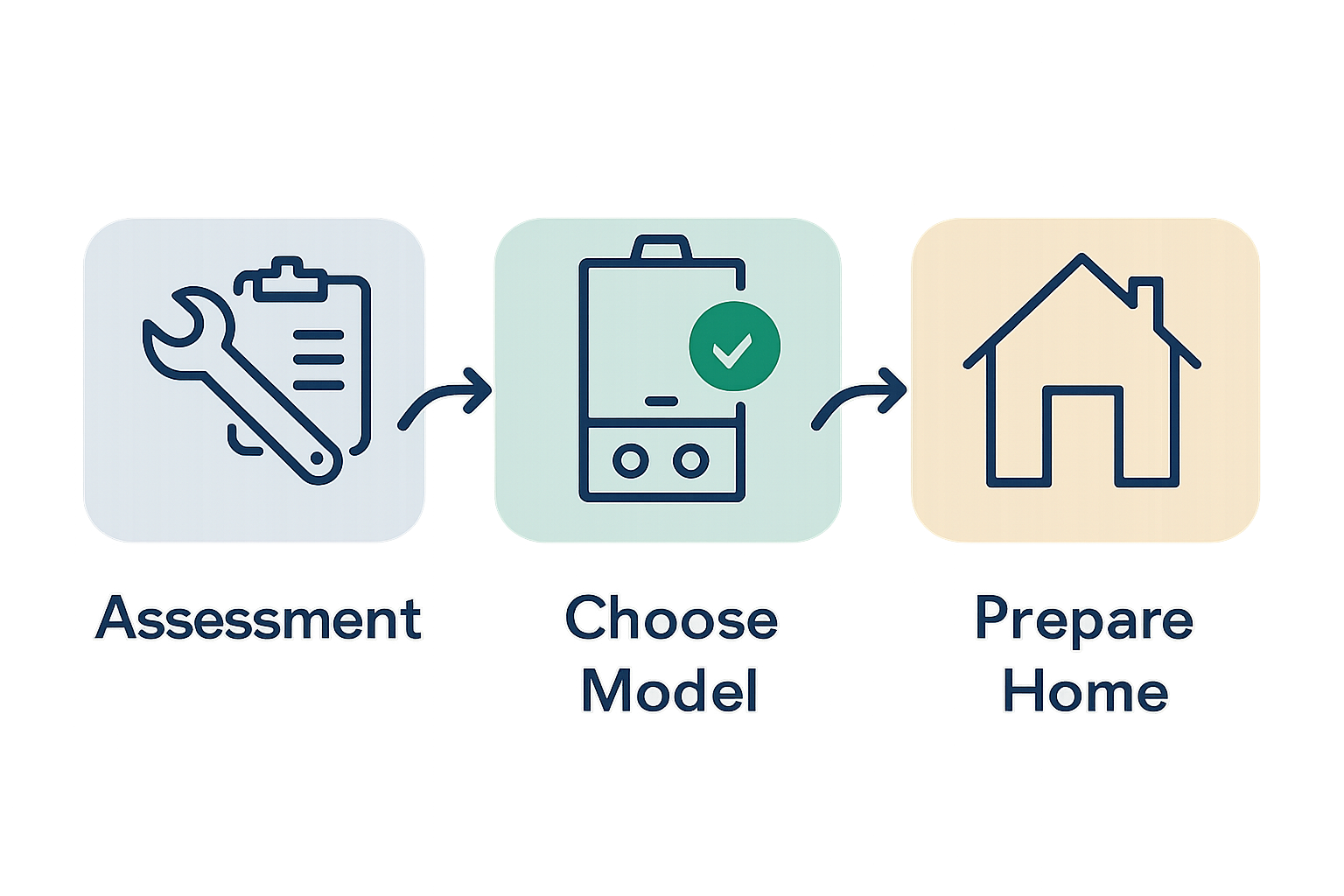
Step 4: Remove the Old Boiler Safely
Removing an old boiler requires meticulous planning, professional expertise, and strict adherence to safety protocols. This critical stage of the boiler replacement process demands careful execution to prevent potential hazards, property damage, and legal complications.
Before initiating the removal, completely disconnect the power supply to your existing boiler. This involves switching off electrical connections at the main circuit breaker and isolating gas supplies. Only a Gas Safe Registered engineer should handle gas disconnections, as improper separation can create significant safety risks. Attempting to disconnect gas connections without professional qualifications is not only dangerous but potentially illegal.
Professional engineers will systematically drain the existing heating system, removing water from radiators and pipework. This process prevents potential water damage during boiler removal and allows for comprehensive system assessment. The drainage procedure requires specialized equipment and expertise to ensure minimal disruption and complete water extraction.
Physical removal of the old boiler involves carefully disconnecting all associated pipework, electrical connections, and mounting fixtures. Experienced professionals will methodically label and document existing connections, facilitating smoother installation of the new system. They will also assess the condition of surrounding infrastructure, identifying any additional repairs or modifications required before new boiler installation.
Our boiler repair specialists recommend comprehensive documentation of the removal process. Photograph the existing installation location, note any observable wear or damage, and retain records of the old system’s specifications. These details can prove invaluable for future maintenance or potential insurance claims.
Responsible disposal of the old boiler is crucial. Professional removal services will ensure environmentally compliant disposal, recycling applicable components and managing potentially hazardous materials according to current regulations. Some metal components can be recycled, reducing environmental impact and potentially offsetting disposal costs.
Careful consideration must be given to the removal site’s condition. Professional engineers will clean the installation area, repair any minor damages, and prepare the space for new boiler mounting. This might involve repairing wall surfaces, checking structural integrity, or addressing any legacy installation issues discovered during the removal process.
Successful completion of this step means your old boiler has been safely, professionally, and systematically removed, creating a clean, prepared environment for your new heating system installation.
Step 5: Install the New Boiler and Connect Utilities
The installation of your new boiler represents a critical moment in the replacement process, requiring precision, expertise, and meticulous attention to technical details. Professional Gas Safe Registered engineers will systematically mount the new unit, ensuring optimal positioning and secure integration with your home’s existing heating infrastructure.
Initial positioning involves precise mounting of the boiler, taking into account ventilation requirements, accessibility for future maintenance, and compliance with current building regulations. Proper wall mounting is crucial, with engineers selecting appropriate fixings that can support the boiler’s weight and withstand vibration during operational cycles. The mounting location must provide adequate clearance for ventilation, access panels, and potential future servicing requirements.
Connecting utility services demands exceptional technical skill. Gas connections require absolute precision, with engineers using specialized tools to create leak-free junctions that meet stringent safety standards. Electrical connections must be carefully integrated, ensuring compatible voltage and amperage specifications. Water connections involve precise pipework modifications, potentially including updates to existing plumbing to accommodate the new boiler’s specific configuration.
Flue installation represents another critical component of the process. Modern condensing boilers typically require specific flue positioning to ensure optimal performance and emissions management. Engineers will carefully assess external wall or roof locations, ensuring proper angle, length, and positioning to facilitate efficient gas expulsion and prevent potential moisture accumulation.
Our boiler installation quote service recommends comprehensive system testing immediately following utility connections. This involves pressurizing the heating system, checking for potential leaks, verifying electrical connections, and conducting initial operational tests to confirm proper functionality across various performance parameters.
Insulation and pipe connections demand particular attention. Any exposed pipework will be carefully insulated to minimize heat loss and improve overall system efficiency. Engineers will ensure all connections are correctly sealed, preventing potential water leakage and maintaining the integrity of your newly installed heating system.
The final stage involves comprehensive system calibration. Professional installers will configure temperature settings, pressure levels, and operational parameters to match your specific household requirements. This precise calibration ensures optimal performance, energy efficiency, and longevity of your new boiler installation.
Successful completion of this step means your new boiler is professionally installed, fully connected, and ready for comprehensive testing and final commissioning.
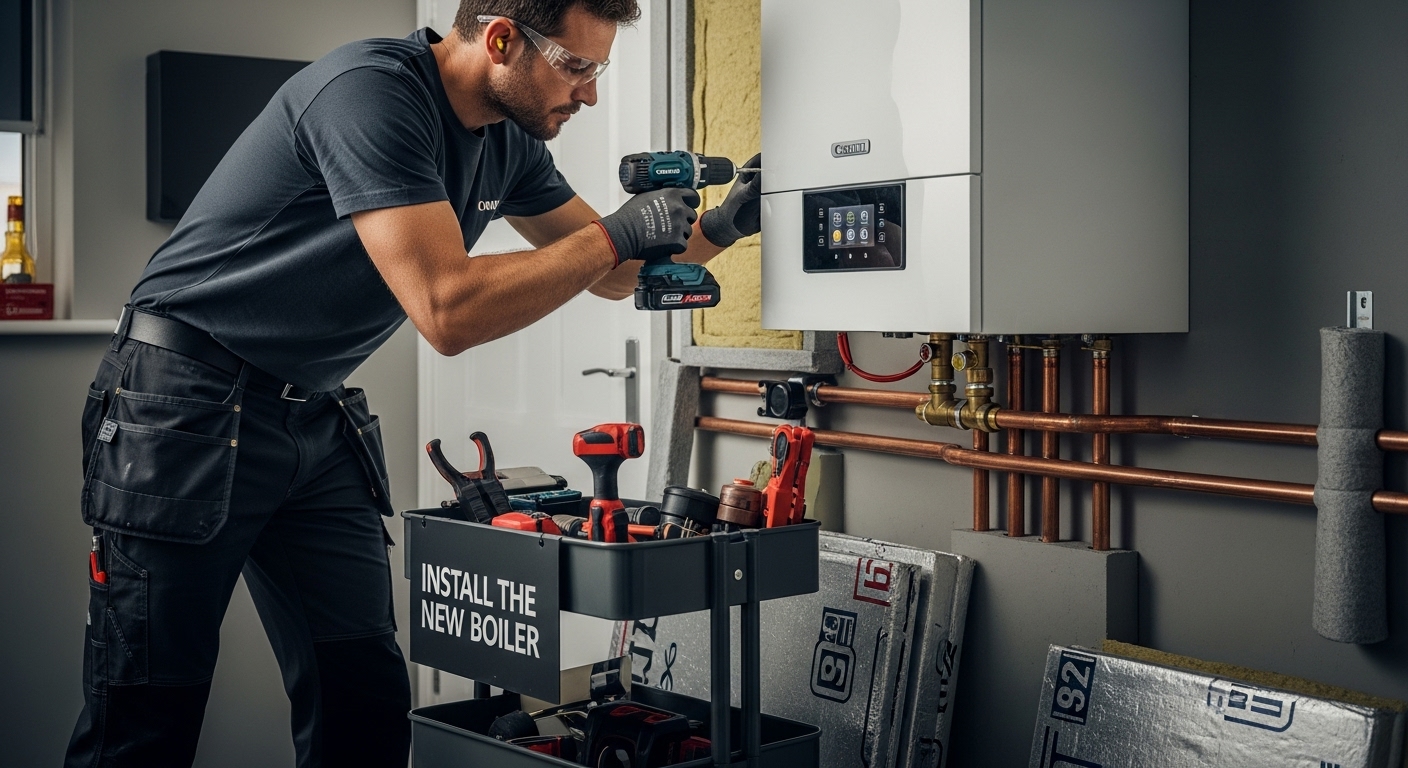
Step 6: Test and Verify Boiler Functionality
Testing and verifying your new boiler’s functionality represents the culmination of the replacement process, ensuring that your investment delivers optimal performance, safety, and efficiency. This critical stage involves comprehensive diagnostic procedures that go far beyond simple operational checks.
Professional engineers will initiate a systematic testing protocol, beginning with pressure system verification. They will carefully monitor system pressure levels, checking for consistent stability across different operational temperatures. Unexpected pressure fluctuations could indicate potential installation issues or underlying system complications that require immediate attention.
The combustion analysis forms a crucial component of functionality testing. Specialized diagnostic equipment measures exhaust gas composition, ensuring the boiler burns fuel with maximum efficiency and minimal environmental impact. Engineers will assess oxygen levels, carbon monoxide concentrations, and overall combustion quality, making precise adjustments to optimize performance and safety.
Heat distribution testing involves monitoring radiator temperatures, checking for consistent warmth across all connected heating zones. Engineers will systematically verify that each radiator heats uniformly, identifying and addressing any potential circulation issues. This process ensures your entire heating system operates at peak efficiency, delivering comfortable and consistent temperatures throughout your property.
Our annual boiler servicing experts recommend comprehensive electrical system checks. This involves verifying control panel functionality, testing safety switches, and confirming that all digital interfaces and temperature management systems operate correctly. Precise calibration of thermostatic controls ensures accurate temperature regulation and energy-efficient performance.
Leak detection represents another critical testing phase. Engineers will conduct pressurized system checks, carefully examining all connection points, pipework, and potential stress areas for even the most minute potential leakage. Identifying and addressing these issues immediately prevents potential long-term damage and ensures system integrity.
Final verification involves a complete operational cycle test, running the boiler through various performance scenarios. This includes assessing hot water production, central heating performance, and overall system responsiveness. Engineers will document all test results, providing you with a comprehensive report detailing the boiler’s initial performance metrics.
Successful completion of this step means your new boiler has undergone rigorous professional testing, confirming its safety, efficiency, and readiness to provide reliable heating and hot water for your home.
Take the Stress Out of Boiler Replacement – Let Local Experts Handle It
Are you feeling overwhelmed by the complexity of the boiler replacement process? If the thought of system assessments, correct model selection, technical installation and rigorous testing feels daunting, you are not alone. Many homeowners and landlords worry about choosing the right boiler or making costly mistakes that disrupt their daily comfort and safety. The article highlights the importance of safe removal, efficient installation and ensuring complete functionality through every step. That is why trusting a team of Gas Safe Registered engineers with proven expertise offers real peace of mind from start to finish.

Why risk a poorly fitted or inefficient heating system? Get a free personalised quote and arrange your next professional boiler replacement with Thermatek. Take advantage of our end-to-end support, from obligation-free installation quotes to long-term servicing. Join thousands across Edinburgh and Midlothian who rely on Thermatek for reliable advice and excellent outcomes. Act now to secure a safer, warmer and more energy-efficient home. Visit our main site to get started today.
Frequently Asked Questions
What are the signs that my boiler needs to be replaced?
Common signs indicating a boiler replacement may be necessary include an age over 10-15 years, inconsistent heating, unusual noises, frequent breakdowns, and rising energy bills.
How do I choose the right type of boiler for my home?
Selecting the right boiler involves considering your home size, insulation quality, number of radiators, and hot water demand. Options include combi boilers for smaller spaces, system boilers for moderate needs, and regular boilers for larger households.
What should I prepare before the new boiler installation?
To prepare, clear the area around your existing boiler, review pipework for potential upgrades, protect surfaces with coverings, and gather relevant documentation. Ensure good ventilation and plan for someone to be present on installation day.
How is the old boiler removed safely?
The old boiler must be disconnected from the power and gas supply by a Gas Safe Registered engineer. They will drain the heating system, disconnect pipework, and dispose of the boiler responsibly, following safety protocols and environmental regulations.
Recommended
- New Boiler Installation & Replacement In Edinburgh - Thermatek Heating
- Annual Boiler Servicing In Edinburgh - Thermatek Heating
- Boiler Repair In Edinburgh | 24/7 Emergency Call Out - Thermatek Heating
- Boiler Installation Quote - Thermatek Heating
Understanding Boiler Lockout Meaning for Homeowners
Boiler lockout might sound like a minor technical hiccup and yet it can grind daily life to a halt in an instant. Imagine waking up to find your central heating silent and the shower icy cold. Unexpected boiler failures can cost thousands of pounds in repairs or even full replacements, but financial loss is only half the story. This safety mechanism is not just a glitch, it is a hidden guardian built to shield both your home and your wellbeing from dangers you cannot see coming.
Table of Contents
- What Is Boiler Lockout?
- Why Is Boiler Lockout Important?
- How Does Boiler Lockout Work?
- Key Concepts Associated With Boiler Lockout
- Real-World Implications Of Boiler Lockout
Quick Summary
| Takeaway | Explanation |
|---|---|
| Boiler lockout prevents dangerous conditions | It automatically shuts down when it detects anomalies, ensuring safety and preventing damage. |
| Recognise lockout indicators immediately | Look for flashing lights or error codes on the display, signaling that manual intervention is needed. |
| Professional help is crucial for persistent lockouts | Continuous lockout signals underlying issues; seek diagnostics to avoid further damage. |
| Boiler lockout protects your finances | Early detection avoids costly repairs by addressing minor problems before they escalate. |
| Understand sensors and controls for effective monitoring | Familiarise yourself with how these systems work to better respond to potential issues. |
What is Boiler Lockout?
A boiler lockout represents a safety mechanism designed to prevent potential damage or dangerous operational conditions within heating systems. When specific critical parameters are compromised, the boiler automatically shuts down, preventing further operation until manual intervention and professional assessment occur.
Understanding the Fundamental Mechanics
Boiler lockout functions as a protective protocol triggered when your heating system detects abnormal operating conditions. These conditions might include:
![]()
- Overheating of internal components
- Pressure inconsistencies within the system
- Electrical fault interruptions
- Critical sensor malfunctions
- Persistent ignition failures
When such anomalies are detected, the boiler’s internal safety controls immediately interrupt the heating cycle, effectively “locking out” further operation. This prevents potential equipment damage, gas leaks, or dangerous thermal expansions that could compromise household safety.
Below is a summary table of the main sensor parameters monitored by a boiler and the operational dangers they are designed to protect against.
| Sensor Parameter | Monitored Issue | Potential Danger Prevented |
|---|---|---|
| Internal temperature levels | Overheating | Equipment damage, thermal expansion |
| System pressure readings | Pressure inconsistencies | Risk of explosion, leaks |
| Electrical current stability | Electrical faults | System shutdown, risk of fire |
| Flame detection and ignition | Ignition failures | Gas leaks, incomplete combustion |
| Gas flow consistency | Gas supply anomalies | Carbon monoxide exposure, gas leaks |
Recognising Lockout Indicators
Homeowners can typically identify a boiler lockout through specific warning signs. Most modern boilers feature digital displays or error codes that illuminate when a lockout occurs.
According to Which? Home Energy, common visual indicators include flashing warning lights, complete system shutdown, and error codes displayed on the control panel.
The lockout mechanism serves as a critical safeguard, ensuring that potentially hazardous operational conditions do not escalate into more serious safety risks. Professional intervention is always recommended when experiencing persistent boiler lockouts, as these might indicate underlying mechanical or electrical issues requiring specialist diagnostic assessment.
While frustrating for homeowners, boiler lockouts represent an essential protective measure designed to maintain both equipment integrity and household safety. Understanding these mechanisms helps residents respond appropriately and seek timely professional support when heating system complications arise.
Why is Boiler Lockout Important?
Boiler lockout serves as a critical safety mechanism designed to protect households from potential catastrophic heating system failures, equipment damage, and significant safety risks. Understanding its importance requires examining the multiple layers of protection it provides for homeowners and their property.
Preventing Potential Hazards
The primary significance of boiler lockout lies in its ability to immediately interrupt potentially dangerous operational conditions. By detecting and responding to critical system anomalies, this safety protocol prevents scenarios that could lead to:
- Gas leaks and potential carbon monoxide exposure
- Thermal expansion and equipment destruction
- Electrical system overloads
- Uncontrolled heating component failures
- Unexpected system explosions or critical breakdowns
According to Gas Safe Register, these preventative measures are crucial in protecting households from potentially life-threatening situations that could arise from undetected heating system malfunctions.
Financial and Property Protection
Beyond immediate safety concerns, boiler lockout mechanisms play a significant role in protecting homeowners from substantial financial investments. Unexpected boiler failures can result in expensive repairs or complete system replacements, which can cost thousands of pounds. By detecting issues early and preventing progressive damage, lockout systems help mitigate potential long-term financial risks.
Moreover, the lockout mechanism ensures that minor technical issues do not escalate into major systemic failures. This proactive approach prevents comprehensive damage to internal heating components, ultimately extending the operational lifespan of expensive heating infrastructure and maintaining the overall efficiency of the home’s thermal management system.
Ultimately, boiler lockout represents more than just a technical safeguard. It embodies a comprehensive approach to home safety, equipment preservation, and responsible household management. By understanding and respecting these built-in protective systems, homeowners can ensure safer, more reliable, and more efficient heating environments.
How Does Boiler Lockout Work?
Boiler lockout operates through a sophisticated system of integrated safety sensors and control mechanisms designed to monitor and respond to potentially dangerous operational conditions within heating systems. This advanced protective protocol ensures immediate intervention when specific critical parameters are compromised.
Sensor and Detection Mechanisms
The lockout process begins with a network of precision sensors strategically positioned throughout the boiler system. These sensors continuously monitor multiple critical operational parameters, including:
- Internal temperature levels
- System pressure readings
- Electrical current stability
- Flame detection and ignition performance
- Gas flow consistency
When any of these sensors detect an anomaly outside the predefined safe operational range, they trigger an immediate shutdown sequence. This instantaneous response prevents potential equipment damage or safety risks before they can escalate into more serious complications.
Electronic Control and Safety Protocols
Modern boilers employ sophisticated electronic control units that interpret sensor data and implement lockout procedures. According to Energy Saving Trust, these control systems use advanced algorithms to distinguish between temporary fluctuations and genuine safety threats.
When a critical issue is detected, the boiler’s control unit will typically:
- Halt fuel supply
- Interrupt electrical connections
- Activate warning indicators
- Prevent further operational attempts
To restore functionality, homeowners must manually reset the system after addressing the underlying issue, which often requires professional diagnostic assessment. This manual reset requirement ensures that potential problems are actively investigated and resolved before the heating system resumes operation.
The intricate design of boiler lockout mechanisms represents a remarkable fusion of safety engineering and intelligent system monitoring. By combining rapid sensor detection, precise electronic controls, and mandatory manual intervention, these systems provide a comprehensive protective framework that prioritizes both equipment integrity and household safety.
Key Concepts Associated with Boiler Lockout
Boiler lockout involves a complex network of technical concepts and safety protocols that extend beyond simple system interruption. Understanding these interconnected elements provides homeowners with deeper insights into their heating system’s operational dynamics and protective mechanisms.
Core Technological Foundations
At the heart of boiler lockout lie several fundamental technological principles that enable precise monitoring and rapid response. These core concepts include:
- Fault detection algorithms
- Thermal resilience thresholds
- Electrical system redundancy
- Sensor calibration protocols
- Automated safety intervention mechanisms
Fault detection algorithms represent sophisticated computational processes that analyse multiple system parameters simultaneously, distinguishing between minor fluctuations and genuine operational threats. These intelligent systems can interpret complex data streams with remarkable precision, ensuring that only genuinely dangerous conditions trigger a complete system shutdown.
Safety and Diagnostic Interactions
Boiler lockout mechanisms incorporate multiple layers of diagnostic interaction designed to protect both equipment and occupants. According to Health and Safety Executive, these interactions involve intricate communication between various system components, creating a comprehensive safety network.
Key diagnostic interactions include:
- Continuous parameter monitoring
- Real-time anomaly identification
- Immediate protective response generation
- Comprehensive error logging
- Systematic reset requirements
The interaction between these diagnostic elements ensures that each potential system irregularity is carefully evaluated, categorised, and responded to with appropriate levels of urgency. Systematic reset requirements play a crucial role in this process, compelling homeowners or professional technicians to actively investigate and resolve underlying issues before system restoration.
By comprehending these intricate technological concepts, homeowners can appreciate boiler lockout not merely as a technical interruption, but as a sophisticated safety ecosystem designed to protect both sophisticated heating infrastructure and residential environments.
Real-World Implications of Boiler Lockout
Boiler lockouts extend far beyond technical inconveniences, presenting significant practical challenges for homeowners, businesses, and institutions. Understanding these real-world implications reveals the profound impact of heating system interruptions on daily life, comfort, and safety.
Residential Disruption and Comfort
In domestic settings, a boiler lockout can transform a comfortable home environment into a challenging living situation. Sudden loss of heating and hot water creates immediate and tangible disruptions:
- Compromised household temperature regulation
- Interruption of daily hygiene routines
- Potential health risks for vulnerable individuals
- Increased stress and domestic discomfort
- Financial costs associated with emergency repairs
Particularly during cold winter months, these disruptions can quickly escalate from minor inconveniences to significant household challenges.
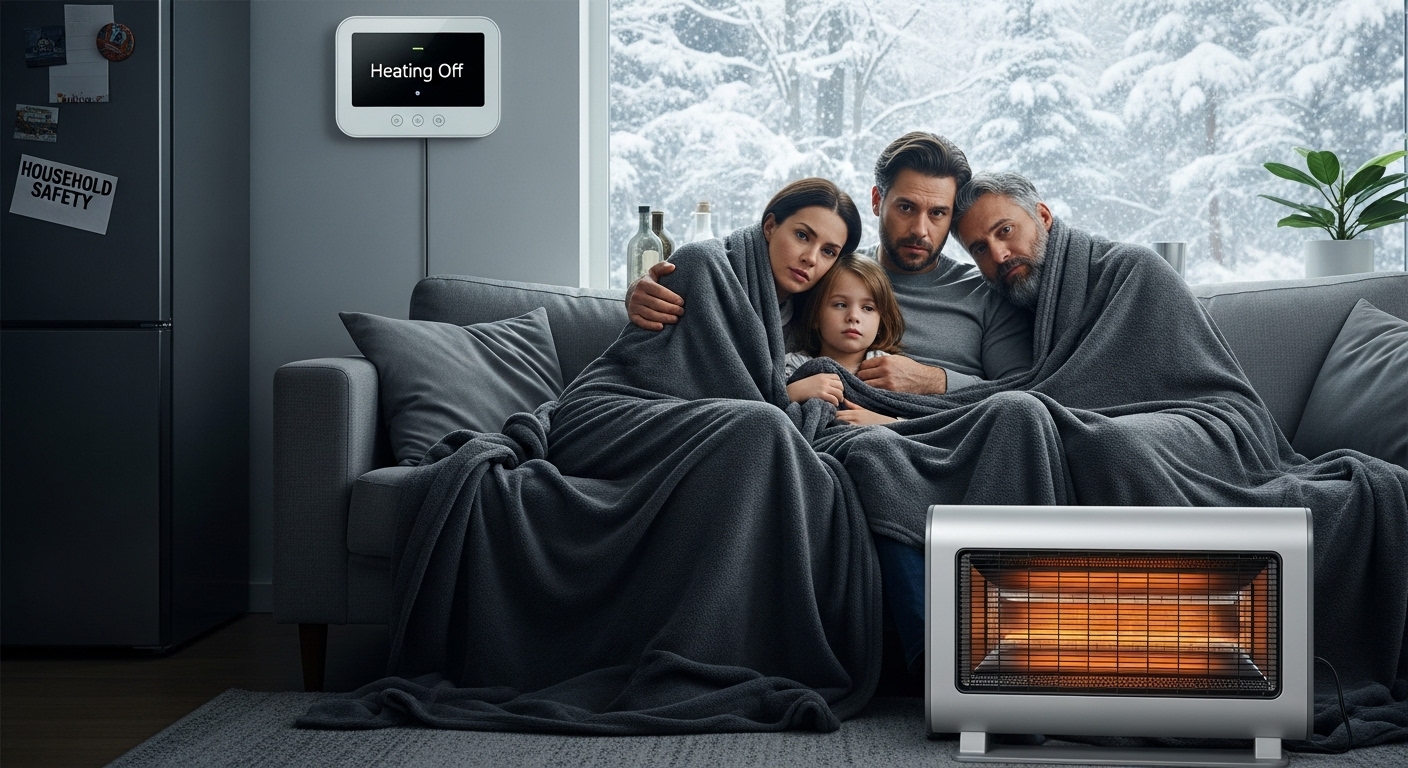 Elderly residents, young children, and individuals with health conditions are especially vulnerable to temperature fluctuations and potential heating system failures.
Elderly residents, young children, and individuals with health conditions are especially vulnerable to temperature fluctuations and potential heating system failures.
Economic and Operational Consequences
Beyond residential impacts, boiler lockouts carry substantial economic implications. According to Health and Safety Executive, unexpected heating system failures can result in:
- Substantial emergency repair expenses
- Potential long-term equipment damage
- Productivity losses in workplace environments
- Increased energy consumption during system recovery
- Potential insurance and liability complications
Professional environments experience particularly acute challenges when heating systems fail. Offices, healthcare facilities, educational institutions, and industrial settings rely on consistent thermal management. A boiler lockout can disrupt critical operations, compromise workplace safety, and generate significant financial repercussions.
The cascading effects of boiler lockouts demonstrate that these are not merely technical events but complex incidents with wide-ranging consequences.
The following table outlines the key consequences of boiler lockout in both residential and professional environments, aiding in understanding its broad impacts.
| Environment | Impact of Boiler Lockout | Examples of Consequences |
|---|---|---|
| Residential | Loss of comfort and routine disruption | No heating or hot water, vulnerable residents |
| Residential | Increased financial burden | Emergency repair costs |
| Residential | Health and safety risks | Cold exposure, potential illness |
| Professional | Operational downtime | Productivity losses, halted services |
| Professional | Greater long-term costs | Equipment damage, insurance complications |
| Professional | Regulatory and workplace safety challenges | Compromised building temperature control |
Restore Heating Confidence with Trusted Boiler Experts
Are recurring boiler lockouts leaving you frustrated and worried about home safety or comfort? If constant error codes or loss of heat have made daily life stressful, you are not alone. Lockouts can signal serious issues like pressure faults or sensor failures. Many homeowners find these disruptions not just inconvenient, but also a risk to their well-being, especially during the colder months. You deserve expert help from professionals who understand heating system safety and efficiency inside out.

Let the local specialists at Thermatek Heating & Plumbing bring you peace of mind. Our Gas Safe Registered engineers have a proven track record for safe, fast, and effective boiler diagnosis and repair across Edinburgh and Midlothian. Whether you need urgent repairs, routine servicing, or support with a persistent lockout, our team is just a click away. Keep your family safe and restore comfort to your home by requesting your free quote now. For reliable, compliant heating care, trust our team to help you get back to normal as soon as possible.
Frequently Asked Questions
What does boiler lockout mean?
A boiler lockout is a safety mechanism that prevents heating systems from operating under potentially dangerous conditions. It automatically shuts down the boiler when critical parameters, such as temperature or pressure, become compromised.
How can I recognize a boiler lockout?
Homeowners can identify a boiler lockout by looking for flashing warning lights, error codes displayed on the control panel, or a complete system shutdown. Most modern boilers include digital displays for these indicators.
Why is boiler lockout important for safety?
Boiler lockout is crucial as it prevents hazardous situations such as gas leaks, thermal expansion, and other system failures that could pose significant safety risks to households and their occupants.
How does boiler lockout work?
Boiler lockout works through a network of sensors that monitor operational parameters like temperature and pressure. If an anomaly is detected, the system triggers a shutdown, halting fuel supply and disabling operation until the issue is resolved.
Recommended
- Annual Boiler Servicing In Edinburgh - Thermatek Heating
- New Boiler Installation & Replacement In Edinburgh - Thermatek Heating
- Boiler Repair In Edinburgh | 24/7 Emergency Call Out - Thermatek Heating
- Boiler Installation Quote - Thermatek Heating
Complete Hot Water Cylinder Maintenance for 2025 Success
Hot water cylinder maintenance often sounds complicated, yet it is the hidden hero behind every warm bath and cosy morning routine. Most people expect their system to run for decades, but cylinders over 10 years old are much more likely to suffer efficiency losses and structural issues. Here’s the twist: with a few strategic checks, your cylinder can run better, cost less to operate, and keep surprises to a minimum all year round.
Table of Contents
- Step 1: Assess Your Hot Water Cylinder Condition
- Step 2: Gather Necessary Tools And Materials
- Step 3: Flush And Clean The Hot Water Cylinder
- Step 4: Inspect And Replace Insulation If Needed
- Step 5: Test Pressure Relief Valve Functionality
- Step 6: Document Maintenance And Schedule Next Check
Quick Summary
| Key Point | Explanation |
|---|---|
| 1. Assess the cylinder’s condition regularly | Conduct thorough inspections to identify any wear, corrosion, or leaks to maintain optimal performance. |
| 2. Gather proper tools and safety gear | Collect high-quality tools and protective equipment to ensure safe and effective maintenance action. |
| 3. Flush and clean the hot water cylinder | Regularly remove sediment and scale buildup to enhance efficiency and prevent bacterial growth in the system. |
| 4. Inspect and replace insulation as needed | Ensure insulation thickness meets modern standards to reduce energy costs and improve heating efficiency. |
| 5. Test and document valve functionality | Regularly check the pressure relief valve for smooth operation and maintain detailed records of maintenance activities. |
Step 1: Assess Your Hot Water Cylinder Condition
Successful hot water cylinder maintenance begins with a thorough and systematic assessment of your system’s current condition. This critical first step helps you understand potential issues, prevent costly repairs, and ensure optimal performance throughout the year.
Understanding Your Cylinder’s Current State
Starting your maintenance journey requires a comprehensive visual and functional inspection. Carefully examine your hot water cylinder for any visible signs of wear, corrosion, or damage. Look closely at external surfaces for rust spots, water stains, or unusual discolouration that might indicate underlying problems. Pay special attention to pipe connections, valves, and seals, checking for potential leakage or deterioration.
The age of your hot water cylinder plays a significant role in determining maintenance needs. Cylinders over 10 years old typically require more frequent and detailed assessments. Older systems are more prone to efficiency losses and potential structural weaknesses. During your inspection, note the cylinder’s manufacturing date and review its service history. If documentation is unavailable, consider consulting a professional heating engineer who can provide a detailed assessment.
Key Inspection Parameters
To conduct a comprehensive evaluation, focus on several critical parameters. Check the cylinder’s insulation integrity by feeling for temperature variations and looking for any visible damage to the insulation jacket. Examine pressure relief valves for smooth operation and listen for any unusual sounds when water flows. Inspect the anode rod if accessible, looking for significant corrosion which might indicate the need for replacement.
According to the Health and Safety Executive, maintaining appropriate water temperatures and system cleanliness is crucial for preventing potential health risks. Your assessment should include verifying that water temperatures can be safely maintained between 60-65 degrees Celsius to minimise bacterial growth while preventing scalding.
If you discover any concerning signs during your inspection such as significant corrosion, persistent leaks, or reduced efficiency, it is recommended to schedule a professional assessment. Professional heating engineers can provide detailed diagnostic services and recommend targeted maintenance or potential replacement strategies.
Step 2: Gather Necessary Tools and Materials
Preparing for hot water cylinder maintenance requires strategic planning and assembling the right equipment. This critical preparatory step ensures you can execute your maintenance tasks efficiently and safely, minimising potential disruptions and preventing unnecessary complications during the process.
Before beginning your maintenance work, gather a comprehensive set of professional-grade tools and protective equipment. Safety should always be your primary consideration. Start by selecting high-quality protective gear including insulated gloves, safety glasses, and non-slip footwear. These items protect you from potential electrical risks, hot surfaces, and unexpected water splashes during maintenance.
Your toolkit should include precision measuring instruments and specialised plumbing equipment. Essential tools include adjustable wrenches, pipe spanners, digital multimeter, pressure gauge, screwdriver set, and leak detection equipment. A thermal imaging camera can be particularly useful for identifying temperature variations and potential insulation issues. Consider investing in digital tools that provide accurate readings and help diagnose potential system problems with greater precision.
Additional materials you will need include thread tape, pipe sealant, cleaning cloths, descaling solution, and replacement components like washers and valve seals. Purchasing high-quality replacement parts specific to your hot water cylinder model is crucial. If unsure about compatibility, consult manufacturer specifications or seek professional advice from a heating engineer.
According to the UK government’s Approved Document G, maintaining proper tools and understanding their application is essential for ensuring system safety and compliance. Familiarise yourself with each tool’s specific function and handle them with care.
Before commencing maintenance, create a dedicated workspace with good lighting and ventilation. Lay down protective sheeting to catch any potential water spillage and keep your tools organised on a clean, stable surface. Ensure you have easy access to your cylinder and sufficient room to manoeuvre. Having a systematic approach to tool preparation will streamline your maintenance process and reduce the likelihood of unexpected challenges.
Below is a summary table of essential tools and materials needed for hot water cylinder maintenance, including their primary purpose and relevant notes to ensure proper preparation.
| Tool/Material | Purpose | Notes |
|---|---|---|
| Insulated gloves | Personal safety | Protects hands from heat and potential electrical hazards |
| Safety glasses | Eye protection | Shields eyes from water splashes and debris |
| Non-slip footwear | Personal safety | Prevents slips on wet surfaces |
| Adjustable wrench / pipe spanner | Loosening/tightening connections | Used for removing valves and pipes |
| Digital multimeter | Electrical testing | Checks for electrical safety on electric systems |
| Pressure gauge | Measuring system pressure | Ensures system is within safe operating limits |
| Screwdriver set | Component access | Opens panels and secures parts |
| Leak detection equipment | Identifies leaks | Pinpoints unnoticed leaks around pipework |
| Thermal imaging camera | Insulation assessment | Detects heat loss and insulation weaknesses |
| Thread tape / pipe sealant | Pipe sealing | Ensures leak-free reconnections |
| Cleaning cloths | General cleaning | Wipes surfaces and removes sediment |
| Descaling solution | Cylinder cleaning | Removes scale and mineral deposits |
| Replacement washers/valve seals | Component renewal | Essential for repairing minor leaks |
| Insulation jacket (as needed) | Thermal protection | Improves energy efficiency if old insulation is inadequate |
Step 3: Flush and Clean the Hot Water Cylinder
Flushing and cleaning your hot water cylinder represents a crucial maintenance step that eliminates sediment buildup, prevents bacterial growth, and ensures optimal system performance. This process removes accumulated minerals, scale, and potential contaminants that can compromise your water quality and heating efficiency.
Begin by completely shutting off the power supply to your hot water cylinder. For electric systems, switch off the circuit breaker, and for gas systems, turn the gas valve to the off position. Safety is paramount during this maintenance procedure. Next, locate the main water supply valve and close it to prevent water from refilling the cylinder during your cleaning process.
Connect a garden hose to the cylinder’s drain valve, ensuring a secure attachment that prevents leakage. Position the other end of the hose in an area that can safely handle the water discharge, such as a floor drain or exterior location. Open the drain valve slowly, allowing water to flow out gradually. This controlled drainage helps prevent sudden pressure changes that could potentially damage your system. As the water drains, you might observe sediment and mineral deposits, which is a clear indication of the necessity of this maintenance procedure.
Once the cylinder is completely drained, prepare a cleaning solution specifically designed for hot water systems. Avoid using harsh chemical cleaners that might damage internal components. Use a specialised descaling solution recommended by your cylinder manufacturer, mixing it according to precise instructions. Gently flush the interior using this solution, allowing it to circulate and break down any remaining mineral deposits or scale buildup.
According to the Health and Safety Executive, regular flushing is crucial for preventing bacterial growth and maintaining water system hygiene. After completing the cleaning process, thoroughly rinse the cylinder with clean water multiple times to ensure no cleaning solution remains.
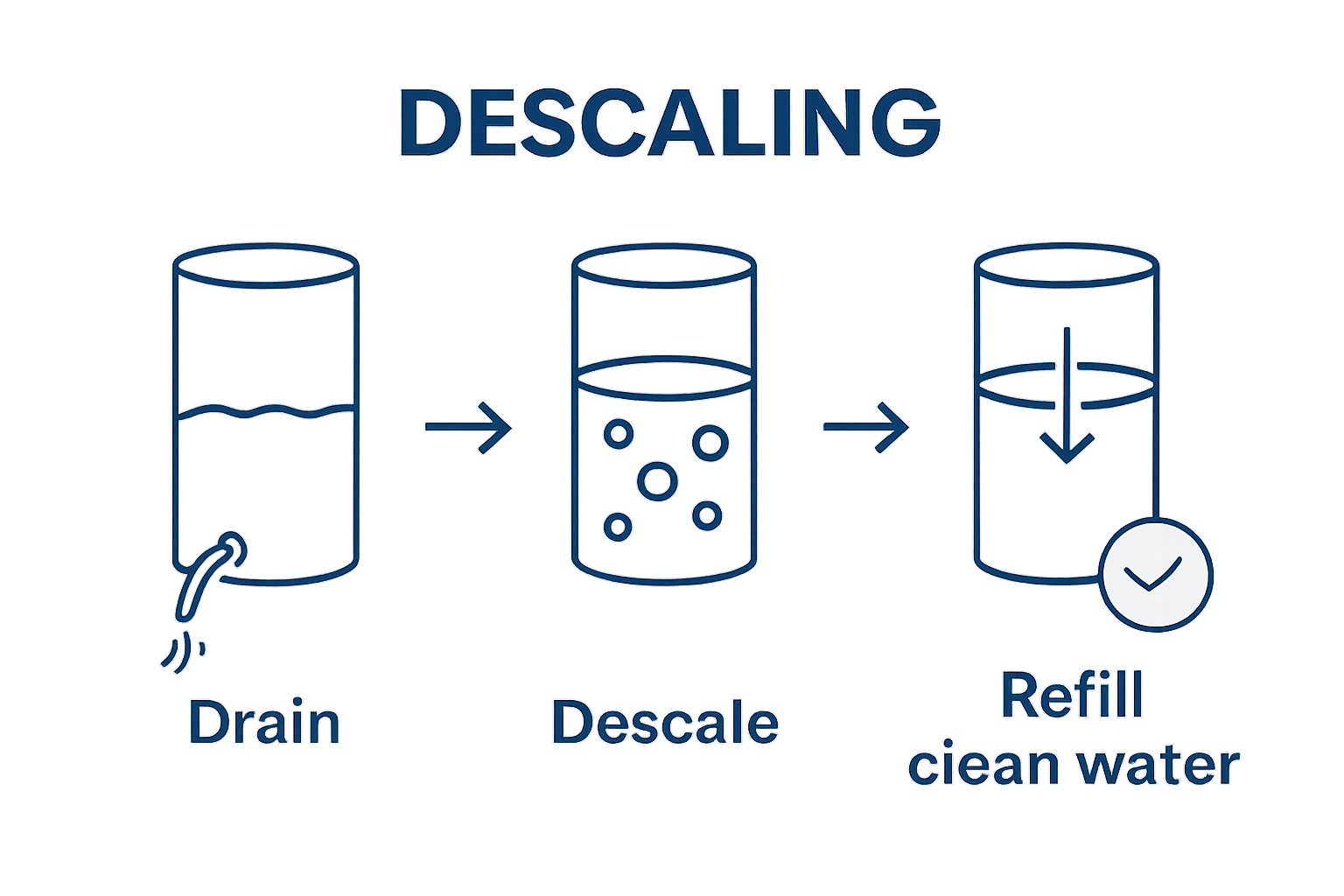 Reconnect all valves, restore water supply, and gradually refill the cylinder, checking carefully for any potential leaks during the refilling process.
Reconnect all valves, restore water supply, and gradually refill the cylinder, checking carefully for any potential leaks during the refilling process.
Verify the system’s performance by restoring power or gas supply and monitoring water temperature and flow. A successful flush should result in clearer water, improved heating efficiency, and reduced risk of potential system complications. If you encounter any unusual sounds, inconsistent water temperatures, or persistent sediment, consider consulting a professional heating engineer for a more comprehensive assessment.
Step 4: Inspect and Replace Insulation if Needed
Proper insulation is the silent guardian of your hot water cylinder’s efficiency, protecting against unnecessary heat loss and reducing energy consumption. This critical maintenance step involves a comprehensive examination of your cylinder’s thermal barrier, ensuring it provides maximum protection and performance.
Visual inspection forms the foundation of effective insulation assessment. Begin by carefully examining the existing insulation jacket, looking for signs of wear, moisture damage, compression, or physical deterioration. Check for any tears, gaps, or areas where the insulation material has become thin or compressed. These imperfections can significantly compromise your cylinder’s thermal performance, leading to increased energy costs and reduced hot water efficiency.
Measure the thickness of your current insulation jacket. Modern recommendations suggest a minimum insulation thickness of 75mm to provide optimal thermal protection. Older installations might have thinner jackets that no longer meet current energy efficiency standards. If your existing insulation is less than 50mm thick or shows considerable signs of degradation, replacement becomes not just advisable but essential.
When selecting a replacement insulation jacket, prioritise materials specifically designed for hot water cylinders. Look for jackets with high thermal resistance ratings and made from durable, moisture-resistant materials. Foam-based and fibreglass jackets are popular choices, offering excellent heat retention properties. Ensure the new jacket fits snugly around your cylinder, covering the entire surface without leaving any exposed areas that could compromise thermal efficiency.
According to the Centre for Sustainable Energy, a well-installed insulation jacket can reduce heat loss by over 75%, potentially saving significant energy costs annually. During installation, pay careful attention to ensuring a tight, seamless fit. Secure the jacket using the provided straps or fastenings, eliminating any potential gaps that could reduce its effectiveness.
After installation, conduct a simple thermal efficiency test. Feel the exterior of the cylinder after several hours of heating. A properly insulated cylinder should feel only slightly warm to the touch, indicating minimal heat loss. If the surface feels excessively hot, it might suggest the need for additional insulation or professional assessment. Keep documentation of your insulation replacement, noting the date, material used, and thickness, which can be valuable for future maintenance and energy efficiency tracking.
Step 5: Test Pressure Relief Valve Functionality
The pressure relief valve serves as a critical safety mechanism in your hot water cylinder, preventing potentially dangerous pressure buildup that could lead to system failure or catastrophic damage. This essential maintenance step involves carefully examining and testing the valve to ensure it operates correctly and provides reliable protection for your entire hot water system.
Safety preparation is paramount before beginning your valve functionality test. Start by wearing protective gloves and safety glasses, as the valve test might involve hot water discharge. Ensure you have a bucket or drainage area prepared to catch any water that might be released during the testing process. Position yourself carefully to avoid potential steam or hot water spray when manipulating the valve.
Locate the pressure relief valve, typically situated near the top or side of your hot water cylinder. This valve features a small lever or test handle that allows manual activation. Before testing, visually inspect the valve and surrounding pipework for any signs of corrosion, mineral buildup, or previous leakage. Check that the discharge pipe is clear and properly positioned to direct water safely away from electrical components or walking areas.
To conduct the test, slowly and deliberately lift the valve’s test lever. A functional pressure relief valve should release water smoothly and consistently, creating a clear, unobstructed flow. Listen carefully for any unusual sounds such as grinding, sputtering, or inconsistent water release. The water should flow freely and stop immediately when you release the lever. If you observe hesitation, partial blockage, or continuous dripping after releasing the lever, this indicates potential valve malfunction requiring professional intervention.
According to the Health and Safety Executive, regular testing of pressure relief valves is crucial for maintaining system safety. After completing the test, carefully wipe away any water and inspect the valve seat for debris or mineral deposits. If you notice persistent issues such as weak water flow, strange noises, or visible damage, do not attempt further repairs yourself. Contact a qualified heating engineer who can perform a comprehensive valve assessment and replacement if necessary.
Verification of a properly functioning pressure relief valve involves observing smooth operation, consistent water discharge, and immediate valve closure. Document the date of your test and any observations, which can help track the valve’s performance over time and provide valuable information for future maintenance or potential replacement.
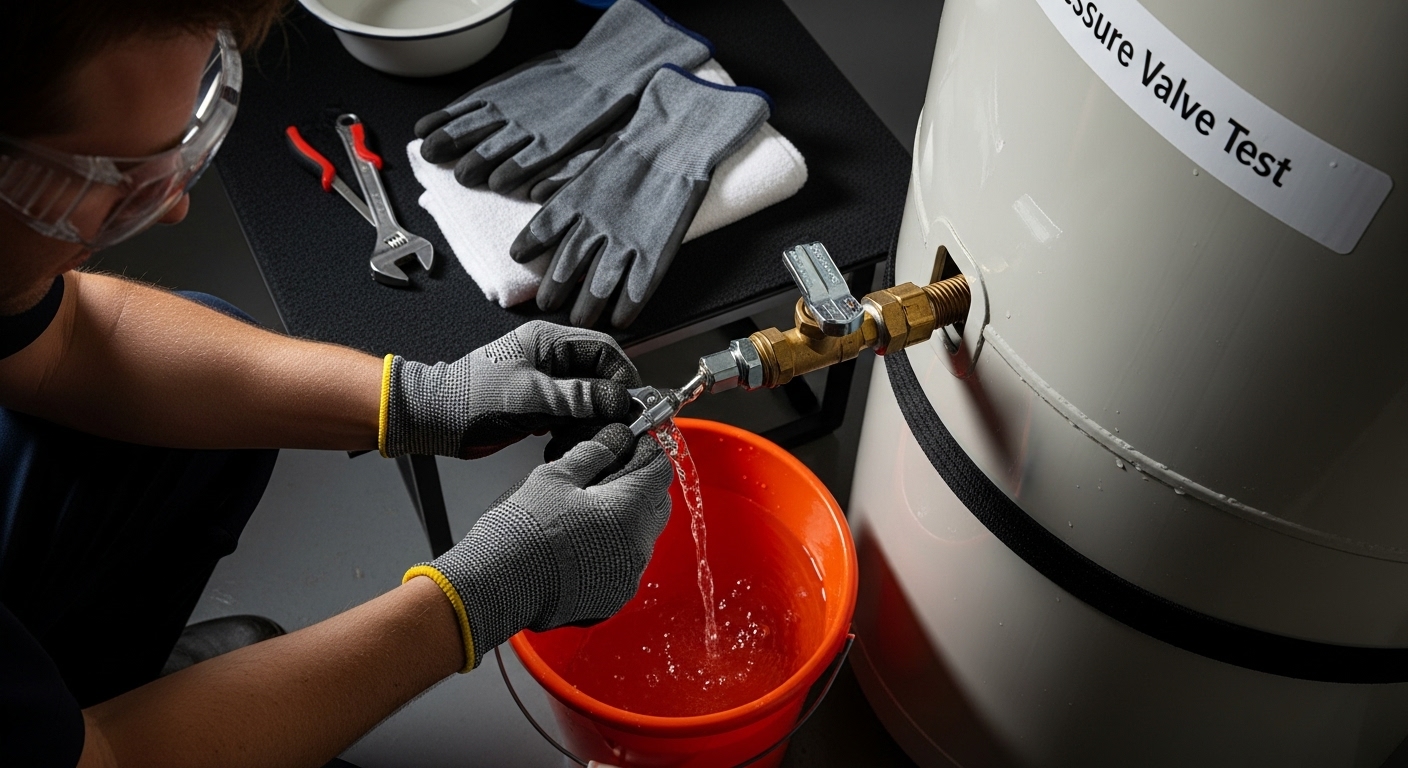
Step 6: Document Maintenance and Schedule Next Check
Documenting your hot water cylinder maintenance represents the final and critically important stage of your service process. This systematic approach ensures you maintain a comprehensive record of your system’s health, performance, and future maintenance requirements, transforming sporadic maintenance into a strategic, proactive management strategy.
Create a dedicated maintenance logbook specifically for your hot water cylinder. This physical or digital record should capture every detail of your current maintenance session. Begin by recording the date of service, ambient temperature during maintenance, current cylinder age, and a detailed inventory of actions performed. Note specific observations such as water quality, insulation condition, valve functionality, and any unusual findings during your inspection. Include precise measurements like insulation thickness, water pressure readings, and temperature variations.
Photographic documentation can provide invaluable visual reference points for future maintenance. Take clear, well-lit images of your cylinder, focusing on areas of potential concern like valve connections, insulation condition, and any identified wear or corrosion. These visual records create a chronological timeline of your system’s condition, helping you track gradual changes that might not be immediately apparent during individual maintenance sessions.
Scheduling your next maintenance check is equally crucial. Most manufacturers recommend comprehensive hot water cylinder maintenance annually, though systems over ten years old might require more frequent inspections. Mark your next scheduled maintenance date in both your physical logbook and digital calendar. Set reminders at least one month in advance to ensure you have sufficient time to prepare tools, arrange professional assistance if needed, and allocate adequate time for a thorough inspection.
According to the Health and Safety Executive, maintaining comprehensive maintenance records demonstrates responsible system management. Consider developing a standardised checklist that covers all critical maintenance aspects. This template can include sections for visual inspection, performance testing, component condition, and recommended future actions. By creating a consistent documentation approach, you transform maintenance from a reactive task into a proactive system management strategy.
Finally, store your maintenance documentation in a secure, easily accessible location. Digital backups provide an additional layer of protection against potential physical document loss. These records not only help you track your hot water cylinder’s performance but can also prove invaluable for warranty claims, potential property sales, or professional assessments in the future.
This checklist helps ensure all key steps of hot water cylinder maintenance are completed and verified for optimal safety and efficiency.
| Maintenance Step | Verification Criteria | Complete (✓/X) |
|---|---|---|
| Visual inspection for wear and corrosion | No rust, stains, or leaks observed | |
| Age and documentation review | Cylinder age noted, service history checked | |
| Insulation jacket assessment | Minimum 75mm thickness, no visible damage | |
| Flushing and cleaning | Sediment removed, clear water upon refill | |
| Pressure relief valve test | Smooth water release, valve closes immediately | |
| Documentation completed | Logbook updated, photos taken | |
| Next maintenance scheduled | Date marked in calendar, reminders set |
Need Reliable Hot Water Cylinder Care? Choose Professional Expertise in Edinburgh and Midlothian
Home maintenance guides can take you far but there is no substitute for the confidence you gain from a fully qualified heating expert. If your inspection has revealed persistent leaks, unreliable hot water, or insulation problems, you are not alone. Many homeowners find the demands of safety checks, sediment flushing, and pressure valve testing can quickly become overwhelming. DIY methods often expose deeper issues that threaten your comfort and efficiency.
Imagine the peace of mind you will have with Gas Safe Registered engineers ensuring every aspect of your hot water cylinder is compliant, safe, and running at peak performance

Why leave your hot water supply to chance? Whether you discovered an ageing system, suspected corrosion, or are simply determined to prevent costly breakdowns, now is the time to put your maintenance in professional hands. Visit Thermatek Heating’s main site to request expert hot water cylinder maintenance, repairs, or upgrades. Enjoy the benefits of trusted local service, clear communication, and ongoing support from a team committed to energy-efficient results. Book your free quote today and take the next step towards reliable, year-round hot water security.
Frequently Asked Questions
What are the signs that my hot water cylinder needs maintenance?
Visible signs such as rust spots, water stains, corrosion, or unusual discolouration are indicators that your hot water cylinder may require maintenance. Reduced efficiency, persistent leaks, and unusual sounds when water flows are also important signals.
How often should I flush and clean my hot water cylinder?
It is recommended to flush and clean your hot water cylinder at least once a year. However, cylinders over 10 years old may benefit from more frequent cleaning to prevent sediment buildup and maintain efficiency.
What should I check during the pressure relief valve test?
During the test, ensure that the valve releases water smoothly and consistently when the test lever is lifted. Listen for any unusual sounds and ensure that water stops flowing immediately after releasing the lever. If you notice weak flow, unusual noises, or continuous dripping, consult a professional.
How can I improve the insulation of my hot water cylinder?
To improve insulation, visually inspect the existing jacket for wear, moisture damage, or compression, and replace it if it’s less than 50mm thick or shows deterioration. Choose high-quality materials designed for hot water cylinders to ensure optimal thermal protection.
Recommended
Understanding Underfloor Heating Explained: A Homeowner's Guide
Underfloor heating is changing the way we stay warm in our homes and workspaces. Most people still picture clunky radiators or draughty rooms, yet underfloor heating can cut energy use by up to 25 percent compared to conventional systems. But it is not just about the savings. The real surprise is how it quietly turns every step into comfort while making draughty corners and bulky radiators a thing of the past.
Table of Contents
- What Is Underfloor Heating And How Does It Work?
- The Benefits Of Underfloor Heating For Homes And Businesses
- Different Types Of Underfloor Heating Systems Explained
- Key Concepts In Underfloor Heating Installation And Maintenance
- Understanding Energy Efficiency And Cost Savings With Underfloor Heating
Quick Summary
| Takeaway | Explanation |
|---|---|
| Underfloor heating provides uniform warmth. | This system eliminates cold spots and drafts, creating a consistently comfortable environment due to even heat distribution. |
| Energy savings of up to 25% are possible. | Lower operational temperatures lead to reduced energy consumption, resulting in significant cost reductions compared to traditional heating methods. |
| Choose between water-based and electric systems. | Water-based systems are ideal for new builds, while electric options are better suited for smaller spaces needing quick installation. |
| Integration with renewable energy is viable. | Underfloor heating systems can connect to heat pumps and other sustainable energy sources, enhancing their environmental credentials. |
| Professional installation ensures compliance and efficiency. | Ensuring proper installation according to regulations optimizes system performance and longevity, reducing potential future issues. |
What is Underfloor Heating and How Does It Work?
Underfloor heating represents an innovative approach to home heating that distributes warmth directly from the floor surface upwards, transforming how residential spaces are thermally managed. Unlike traditional radiator systems that heat rooms from wall-mounted units, underfloor heating creates a consistent, gentle heat that spreads evenly across entire floor areas.
Types of Underfloor Heating Systems
Two primary underfloor heating technologies dominate the market: water-based (hydronic) and electric systems. Water-based systems circulate warm water through a network of pipes embedded within floor construction, typically installed beneath floor screeds or within suspended flooring. These systems connect to central heating sources like boilers or heat pumps, pumping heated water through carefully designed pipe layouts.
Electric underfloor heating utilises thin heating mats or cables installed directly underneath floor coverings. These systems are particularly suited for smaller spaces like bathrooms or kitchens, where quick installation and zone-specific heating are desirable. Electric systems offer simpler retrofitting compared to water-based alternatives but generally have higher operational costs.
Operational Mechanics and Efficiency
Underfloor heating operates at significantly lower temperatures compared to conventional radiator systems, typically between 35-45 degrees Celsius. This lower temperature requirement delivers multiple advantages. According to research from the UK Government’s Heat and Buildings Strategy, lower flow temperatures enhance overall system efficiency and reduce energy consumption.
Key benefits of underfloor heating include:
- Uniform heat distribution across entire floor surfaces
- Reduced dust circulation compared to traditional radiators
- Enhanced room aesthetics without visible heating equipment
- Potential energy savings through lower operating temperatures
The system’s design ensures heat radiates upwards, creating a comfortable thermal environment where warmth surrounds occupants from the ground up, unlike traditional heating methods that create temperature stratification with warmer air near the ceiling and cooler air at floor level.
The Benefits of Underfloor Heating for Homes and Businesses
Underfloor heating transcends traditional heating approaches, offering substantial advantages for residential and commercial environments. This innovative heating solution provides more than mere temperature control, delivering comprehensive comfort and efficiency across diverse property types.
Comfort and Thermal Efficiency
The primary appeal of underfloor heating lies in its superior thermal distribution. Unlike conventional radiators that create localised hot spots, underfloor systems generate uniform warmth across entire spaces. This even heat distribution eliminates cold zones and drafts, creating a consistently comfortable environment. Occupants experience warmth radiating gently upwards, mimicking natural thermal dynamics and providing a more pleasant sensory experience.
Energy Performance and Cost Savings
Underfloor heating systems demonstrate remarkable energy efficiency. Research from the Energy Saving Trust reveals that these systems operate at significantly lower temperatures compared to traditional radiators while maintaining optimal thermal comfort. Lower operational temperatures translate directly into reduced energy consumption and decreased utility expenses.
Key economic advantages include:
- Potential energy savings of up to 25% compared to conventional heating systems
- Reduced carbon emissions through more efficient heat distribution
- Lower long-term maintenance requirements
- Increased property value through modern heating infrastructure
For businesses seeking efficient heating solutions, underfloor heating offers a compelling proposition. Commercial spaces can benefit from improved thermal management, reduced operational costs, and enhanced environmental credentials.
Versatility and Design Flexibility
Underfloor heating provides unparalleled design flexibility for both residential and commercial spaces. By eliminating bulky radiators, property owners gain additional wall space and design freedom. This system accommodates various floor coverings including tiles, wood, carpet, and stone, making it adaptable to diverse aesthetic preferences and functional requirements.
Business owners and homeowners alike appreciate the system’s ability to integrate seamlessly with modern interior design concepts, creating clean, uncluttered environments that prioritise both form and function.
Different Types of Underfloor Heating Systems Explained
Underfloor heating technologies have evolved significantly, offering diverse solutions tailored to specific residential and commercial requirements. Understanding the nuanced differences between system types enables property owners to make informed decisions about their heating infrastructure.
Water-Based (Wet) Underfloor Heating Systems
Water-based underfloor heating, also known as hydronic systems, represent the most energy-efficient approach to floor warming. These systems circulate heated water through a network of pipes embedded within floor structures, typically installed beneath screed layers or within floor constructions. According to research from the Centre for Sustainable Energy, these systems can be connected to various heat sources including:
- Condensing boilers
- Heat pumps
- Solar thermal systems
- Renewable energy installations
Water-based systems are particularly advantageous in new construction projects where floor levels can be adjusted to accommodate pipe networks.
They offer superior long-term energy efficiency and can be integrated with multiple heating technologies.
Electric Underfloor Heating Systems
Electric underfloor heating provides an alternative solution, especially suitable for retrofit scenarios or smaller spaces. These systems utilise thin heating mats or cables installed directly beneath floor coverings. Key characteristics include:
- Faster installation compared to water-based systems
- Lower upfront installation costs
- Ideal for bathrooms, kitchens, and smaller rooms
- More straightforward retrofitting process
While electric systems offer flexibility, they typically have higher operational costs compared to water-based alternatives. They excel in providing zone-specific heating and can be easily controlled through programmable thermostats.
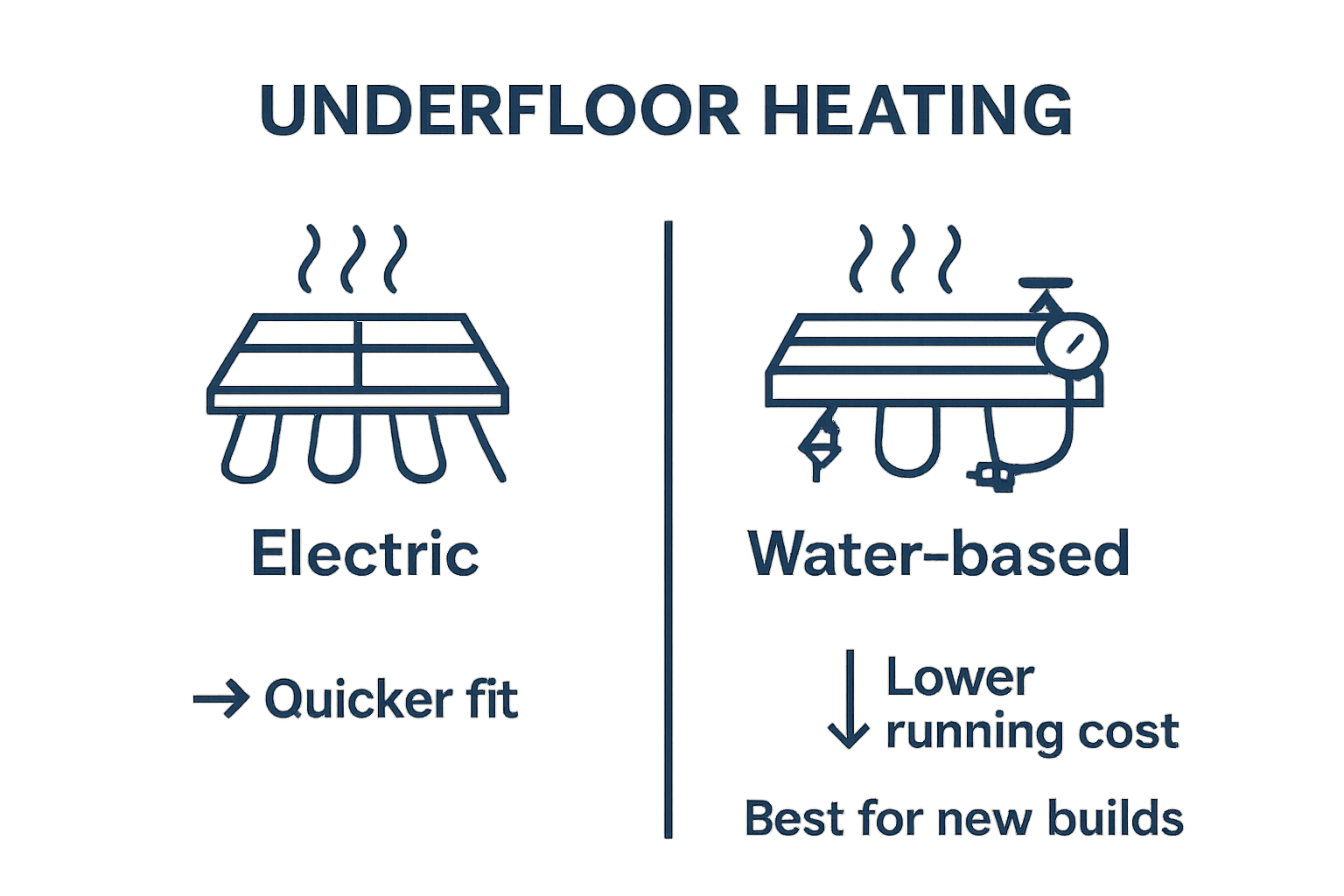
Low-Profile and Specialist Underfloor Heating Solutions
Recent technological advancements have introduced low-profile underfloor heating systems designed for renovation projects with limited floor height restrictions. These innovative solutions include aluminium plate systems and ultra-thin heating networks that can be installed with minimal structural modifications.
For comprehensive heating solutions, property owners can select from multiple system configurations, ensuring optimal thermal comfort tailored to specific spatial and budgetary constraints.
To help readers quickly compare the main types of underfloor heating, the following table summarises their key characteristics, advantages, and considerations:
| System Type | Key Features | Advantages | Ideal Application Scenarios |
|---|---|---|---|
| Water-based (Hydronic) | Network of pipes, uses hot water from boiler or heat pump | High energy efficiency, compatible with renewables, good for large areas | New builds, extensive renovations |
| Electric | Thin heating mats or cables under flooring | Quick installation, zone heating, lower upfront cost | Bathrooms, kitchens, retrofits, small zones |
| Low-profile/Specialist | Ultra-thin, minimal floor height addition | Suited to renovations, flexible installation in tight spaces | Older properties, projects with height restrictions |
Key Concepts in Underfloor Heating Installation and Maintenance
Successful underfloor heating implementation requires comprehensive understanding of technical considerations, regulatory compliance, and strategic planning. Homeowners and property managers must navigate multiple complex factors to ensure optimal system performance and long-term reliability.

Installation Considerations and Technical Requirements
Proper floor preparation forms the critical foundation for effective underfloor heating systems. Research from the UK Government’s Solid Floor Insulation Guide emphasizes the importance of meticulous groundwork before system implementation. Key technical prerequisites include:
- Comprehensive subfloor assessment
- Adequate thermal insulation
- Precise pipe or heating element placement
- Compatibility with existing floor structures
Professional evaluation ensures that floor surfaces can support the heating infrastructure without compromising structural integrity or thermal efficiency. Considerations vary significantly between new constructions and retrofit scenarios, demanding tailored approaches for each unique property.
To clarify the installation and maintenance journey for underfloor heating, this table outlines essential considerations and requirements at each stage:
| Stage | Key Considerations | Requirements |
|---|---|---|
| Preparation & Floor Assessment | Subfloor inspection, insulation, structural compatibility | Professional evaluation, compliance with floor structure |
| Installation | Correct placement, suitable system choice, regulation alignment | Certified installers, documentation, adherence to Building Regulations |
| Maintenance & Performance | Regular checks, system integrity, performance optimisation | Periodic inspections, smart thermostat upgrades, professional servicing |
Regulatory Compliance and Professional Standards
Underfloor heating installations must adhere to stringent building regulations and safety standards. Professional certification becomes paramount in ensuring system reliability and legal compliance. Installers must demonstrate technical competence and understanding of complex thermal engineering principles.
Critical compliance elements include:
- Gas Safe registration for water-based systems
- Electrical certification for electric underfloor heating
- Adherence to building regulation Part L (conservation of fuel and power)
- Comprehensive system design documentation
Maintenance and Long-Term Performance
Ongoing maintenance represents a crucial aspect of underfloor heating system management. Regular professional inspections help prevent potential issues and maintain system efficiency. Property owners should prioritize periodic system checks, including pipe integrity assessments and thermal performance evaluations.
For advanced heating management, integrating smart thermostat technologies can provide enhanced monitoring and control, enabling more precise temperature regulation and energy optimization.
Understanding Energy Efficiency and Cost Savings with Underfloor Heating
Underfloor heating represents a sophisticated approach to thermal management, offering substantial energy efficiency advantages over traditional heating systems. By reimagining how warmth is distributed throughout living spaces, these innovative systems deliver significant economic and environmental benefits.
Thermal Performance and Energy Consumption
Lower operational temperatures constitute the primary mechanism behind underfloor heating’s energy efficiency. Unlike conventional radiators that require high-temperature water circuits, underfloor systems operate effectively at substantially reduced temperatures. According to the UK government’s Great British Insulation Scheme, these systems can generate substantial financial savings:
- Potential annual energy bill reductions of up to 370
- Reduced carbon emissions compared to traditional heating
- More uniform heat distribution across living spaces
- Enhanced thermal comfort at lower energy consumption levels
The system’s ability to distribute heat evenly minimises energy waste, creating a more sustainable heating solution for modern properties.
Economic Considerations and Long-Term Investment
While initial installation costs for underfloor heating can be higher than traditional systems, the long-term financial benefits are considerable. Comprehensive cost analysis reveals multiple economic advantages:
- Reduced monthly energy expenditure
- Increased property value through modern heating infrastructure
- Lower maintenance requirements
- Potential eligibility for energy efficiency incentives
Homeowners can expect gradual returns on their initial investment through consistent energy savings and improved thermal performance.
Environmental Impact and Sustainability
Underfloor heating aligns closely with contemporary sustainability objectives. By operating at lower temperatures and delivering more efficient heat distribution, these systems contribute meaningfully to reducing household carbon footprints. The technology’s compatibility with renewable energy sources like heat pump installations further enhances its environmental credentials, supporting broader national decarbonisation strategies.
Upgrade Your Comfort and Efficiency with Expert Underfloor Heating Support
Are you worried about uneven heating, high energy bills, or struggling to achieve that perfect level of comfort in your home as explained in Understanding Underfloor Heating Explained: A Homeowner’s Guide? Many homeowners feel frustrated by cold spots and the complicated choices between water-based and electric underfloor heating systems. The desire for reliable warmth, better air quality, and increased property value makes professional support essential. Our Gas Safe Registered engineers have extensive experience with all aspects of underfloor heating installation, maintenance, and integration with renewable solutions such as heat pumps. We understand the technical requirements, from floor insulation to smart thermostat controls, and ensure every installation is safe, energy-efficient, and fully compliant.

Ready for even, efficient heating tailored to your Edinburgh or Midlothian property? Take the next step by visiting Thermatek Heating & Plumbing. Contact us now for expert advice, a free quote, or to learn how underfloor heating can transform your indoor comfort. Don’t wait to experience a warmer, more efficient home.
Frequently Asked Questions
What is underfloor heating?
Underfloor heating is a system that warms a room by distributing heat directly from the floor surface upwards, as opposed to traditional radiators that release heat from the walls. It can operate through water-based (hydronic) systems or electric heating mats and cables.
What are the benefits of installing underfloor heating?
Underfloor heating offers several advantages, including uniform heat distribution, reduced dust circulation, improved energy efficiency, lower operating temperatures, and enhanced aesthetics without visible heating equipment, which can lead to energy savings and increased property value.
How does water-based underfloor heating work?
Water-based underfloor heating systems circulate warm water through a network of pipes installed beneath the floor. These systems can connect to various heat sources, such as boilers or heat pumps, and provide efficient warmth across the entire floor area.
Is electric underfloor heating suitable for larger spaces?
While electric underfloor heating is easy to install and ideal for smaller areas, it is generally less efficient for heating larger spaces compared to water-based systems. Electric systems are best for specific zones, such as bathrooms or kitchens, where quick and responsive heating is needed.
Recommended
- Local Heating Installer Kicks Off His New Business With £500 Birthday Present
- Air Source Heat Pump Installation In Edinburgh
- News
- Boiler Installation Quote
Understanding Air Source Heat Pump Benefits for Homes
Air source heat pumps are changing how homes are heated across the UK. While some people expect green technology to be less powerful, these systems can deliver about 3 to 4 units of heat for every single unit of electricity used. The surprise is they keep working efficiently even when the temperature outside drops as low as minus 15 degrees, making them a smart option even for chilly British winters.
Table of Contents
- What Are Air Source Heat Pumps?
- Why Choose Air Source Heat Pumps For Heating?
- How Do Air Source Heat Pumps Work?
- Environmental And Economic Benefits Of Air Source Heat Pumps
- Real-World Applications And Considerations
Quick Summary
| Takeaway | Explanation |
|---|---|
| Air source heat pumps enhance energy efficiency | They generate 3-4 units of heat for every unit of electricity consumed, significantly improving energy performance in homes. |
| They reduce carbon emissions significantly | Utilizing renewable energy from outside air, these systems can decrease household carbon emissions by up to 70% compared to traditional heating methods. |
| Potential long-term cost savings available | Although initial installation costs are higher, ongoing savings on energy bills can offset expenses over time, aided by government incentives. |
| Adaptable for various property types | Air source heat pumps can be installed in diverse buildings, from modern flats to older houses, and integrate with existing heating systems. |
| Regular maintenance is crucial for performance | Annual professional inspections and routine servicing help maintain efficiency and prolong the lifespan of the heat pump system. |
What are Air Source Heat Pumps?
Air source heat pumps represent an innovative renewable heating technology designed to extract warmth from outside air and efficiently transfer it into residential spaces. Unlike traditional heating systems that generate heat through combustion, these intelligent devices capture existing environmental heat and upgrade its temperature for home heating and hot water purposes.
How Air Source Heat Pumps Function
At their core, air source heat pumps operate using a sophisticated thermodynamic process. They work similarly to refrigerators but in reverse, absorbing ambient heat from outside air through an external unit, even when temperatures are as low as -15°C. According to Energy Saving Trust, these systems can extract heat energy from the atmosphere and convert it into usable warmth for domestic environments.
The technical mechanism involves three primary components:
- An external heat exchanger that absorbs exterior air temperature
- A compressor that increases the captured heat’s temperature
- A heat distribution system including radiators or underfloor heating
Through this process, air source heat pumps can generate approximately 3-4 units of heat for every single unit of electrical energy consumed, making them substantially more efficient than conventional gas or electric heating systems.
Environmental and Economic Benefits
Air source heat pumps offer significant advantages for homeowners seeking sustainable and cost effective heating solutions. By utilising renewable energy from atmospheric heat, these systems dramatically reduce carbon emissions compared to fossil fuel alternatives. They operate with minimal environmental impact and can help households transition towards greener energy consumption.
Financially, while initial installation costs might be higher than traditional heating systems, homeowners can experience long term savings through reduced energy bills and potential government incentives for adopting renewable technologies. The efficiency of these systems means lower ongoing energy expenditure and a reduced carbon footprint.
Moreover, modern air source heat pumps are designed to work effectively in UK climate conditions, providing consistent heating even during colder months. Their versatility allows installation in various property types, from modern apartments to older residential buildings, making them an increasingly popular choice for environmentally conscious homeowners.
Why Choose Air Source Heat Pumps for Heating?
Choosing air source heat pumps represents a strategic decision for homeowners seeking efficient, environmentally responsible heating solutions. These advanced systems offer compelling advantages that extend far beyond traditional heating methods, providing a comprehensive approach to domestic energy management.
Energy Efficiency and Cost Savings
Air source heat pumps deliver exceptional energy performance, transforming how households consume and manage heating resources. Research from the Carbon Trust indicates that these systems can reduce energy consumption by up to 50% compared to conventional heating technologies. Their remarkable efficiency stems from their ability to transfer heat rather than generate it, which translates directly into significant financial savings.
To help clarify how air source heat pumps outperform traditional heating systems, the table below compares key characteristics of each approach.
| Feature / Characteristic | Air Source Heat Pump | Traditional Gas Boiler |
|---|---|---|
| Method of Heat Generation | Transfers heat from outside air | Burns gas to generate heat |
| Heat Output per Unit of Electricity | 3-4 units of heat per 1 unit used | 0.85-0.95 units per 1 unit used |
| Carbon Emissions | Up to 70% lower than gas boiler | High, due to direct fossil fuel use |
| Suitability in Low Temperatures | Operates efficiently to -15°C | No impact from low outside air |
| Installation Cost | Higher initial investment | Lower upfront cost |
| Operating Cost Over Time | Lower, possible long-term savings | Higher, fluctuates with fuel prices |
| Maintenance Requirements | Annual servicing recommended | Annual servicing recommended |
Key efficiency characteristics include:
- Generating 3-4 units of heat for every unit of electrical energy consumed
- Operating effectively across varied temperature ranges
- Reducing overall household energy expenditure
The long term financial benefits make air source heat pumps an attractive investment for homeowners planning sustainable energy strategies.
 While initial installation costs may appear higher, the reduced operational expenses provide substantial economic advantages over traditional heating systems.
While initial installation costs may appear higher, the reduced operational expenses provide substantial economic advantages over traditional heating systems.
Environmental Impact and Sustainability
Environmental consciousness is increasingly driving heating technology choices, and air source heat pumps excel in this domain. By harnessing renewable energy from atmospheric heat, these systems dramatically reduce carbon emissions. They eliminate direct fossil fuel combustion, contributing significantly to household decarbonization efforts.
Moreover, as electricity grids transition towards renewable energy sources, air source heat pumps become even more environmentally beneficial. Their compatibility with green electricity generation makes them a forward thinking solution for eco conscious homeowners. If you’re interested in learning more about professional installation in your area, read our guide on air source heat pump installation.
Versatility and Technological Adaptability
Modern air source heat pumps are engineered to perform effectively across diverse property types and architectural configurations. Whether installed in compact urban apartments or spacious rural homes, these systems offer remarkable adaptability. They can integrate seamlessly with existing radiator networks or underfloor heating, providing flexible heating solutions that accommodate varied domestic environments.
Advanced models now feature smart technology interfaces, enabling precise temperature control and energy monitoring. This technological sophistication allows homeowners to optimize their heating systems, further enhancing overall energy efficiency and comfort.
How Do Air Source Heat Pumps Work?
Air source heat pumps represent a sophisticated energy transfer technology that harnesses atmospheric thermal energy through an ingenious thermodynamic process. By capturing ambient heat from outside air and converting it into usable warmth, these systems provide an innovative alternative to traditional heating methods.
The Thermodynamic Heat Transfer Process
The fundamental mechanism of air source heat pumps revolves around transferring heat energy rather than generating it directly.
According to Energy Saving Trust, these systems extract heat from outside air, even when external temperatures are remarkably low, typically functioning effectively at temperatures as low as -15°C.
The heat transfer process involves several critical stages:
- Absorbing ambient heat through an external unit
- Compressing the captured heat to increase its temperature
- Distributing the upgraded thermal energy throughout residential spaces
A specialized refrigerant fluid plays a crucial role in this process. As the fluid circulates through the system, it absorbs low temperature heat from the external environment, which is then compressed to significantly raise its thermal potential.
Components and Operational Mechanics
Air source heat pumps comprise three primary components that work in synchronised harmony: the external air collection unit, the heat exchanger, and the internal distribution system. The external unit contains a fan that draws in outside air, passing it over a heat exchanger containing the refrigerant fluid.
As the refrigerant absorbs heat, it transforms from a liquid to a gas. This gaseous refrigerant then enters a compressor, which increases its temperature through mechanical compression. The now high temperature gas transfers its thermal energy to water or air, which can be distributed through radiators, underfloor heating systems, or forced air networks.
For a streamlined understanding, the following table outlines the main components of air source heat pumps and summarises their core functions within the system.
| Component | Primary Function |
|---|---|
| External Heat Exchanger | Absorbs heat energy from outdoor air |
| Compressor | Raises the temperature of the absorbed heat by compressing refrigerant |
| Refrigerant Fluid | Circulates through system to carry and upgrade absorbed heat |
| Indoor Heat Distribution | Delivers heat via radiators, underfloor, or air systems |
| Expansion Valve | Reduces refrigerant pressure and temperature to repeat cycle |
| Control System | Regulates temperature and system operation |
Efficiency and Performance Characteristics
The exceptional performance of air source heat pumps stems from their ability to generate multiple units of heat for each unit of electrical energy consumed. Modern systems can produce approximately 3-4 units of thermal energy for every single unit of electricity used, making them substantially more efficient than conventional heating technologies.
This impressive efficiency is achieved through advanced engineering that minimises energy losses during the heat transfer process. By leveraging the principles of thermodynamics, learn more about our professional heat pump installation services that can help you transition to this cutting edge heating technology.
Environmental and Economic Benefits of Air Source Heat Pumps
Air source heat pumps represent more than just an advanced heating technology they are a pivotal solution for addressing both environmental sustainability and economic efficiency in residential energy management. By integrating cutting edge thermodynamic principles with renewable energy strategies, these systems offer transformative benefits for homeowners and the broader ecosystem.
Carbon Emission Reduction
Research from the UK Government highlights that heating contributes over a third of UK carbon emissions. Air source heat pumps dramatically reduce this environmental impact by generating heat through energy transfer rather than fossil fuel combustion. These systems can potentially decrease carbon emissions by up to 70% compared to traditional gas boilers, making them a critical technology in achieving national decarbonization objectives.

Key environmental advantages include:
- Minimal direct greenhouse gas emissions
- Compatibility with renewable electricity generation
- Significant reduction in household carbon footprint
As electricity grids progressively transition towards renewable sources, the environmental benefits of air source heat pumps will continue to amplify, positioning them as a forward thinking heating solution.
Long Term Economic Advantages
Beyond environmental benefits, air source heat pumps deliver substantial economic value for homeowners. While initial installation costs might appear higher than conventional heating systems, the long term financial gains are significant. These systems generate approximately 3-4 units of heat for every unit of electrical energy consumed, translating into considerable energy bill reductions.
Government initiatives further enhance the economic attractiveness of heat pumps. The Boiler Upgrade Scheme provides financial support, making these systems more accessible. Homeowners can potentially save hundreds of pounds annually on heating expenses while simultaneously increasing their property’s energy efficiency rating.
Technological and Societal Impact
The widespread adoption of air source heat pumps extends beyond individual household benefits. Learn more about our professional heat pump installation services that contribute to a broader technological transformation. These systems represent a critical component of the UK’s strategy to achieve Net Zero emissions, driving innovation in renewable energy infrastructure.
Moreover, the heat pump industry is generating significant economic opportunities, with potential job creation in manufacturing, installation, and maintenance sectors. By investing in this technology, homeowners are not just improving their personal energy management but participating in a broader societal shift towards sustainable infrastructure.
Real-World Applications and Considerations
Air source heat pumps represent a versatile heating technology with applications spanning diverse residential and commercial environments. Understanding their practical implementation requires careful evaluation of specific property characteristics, installation requirements, and potential performance limitations.
Property Suitability and Architectural Considerations
Research from the Energy Saving Trust indicates that air source heat pumps can be effectively integrated into various property types, from modern apartments to traditional homes. However, successful implementation depends on several critical architectural factors that homeowners must carefully assess.
Key property evaluation criteria include:
- Adequate external space for heat pump unit installation
- Existing insulation quality and thermal efficiency
- Compatibility with current heating distribution systems
- Electrical infrastructure capacity
Homes with robust insulation and well-designed thermal envelopes typically experience superior heat pump performance. Older properties might require preliminary energy efficiency upgrades to maximize the system’s effectiveness, potentially involving additional wall, roof, or floor insulation improvements.
Performance Parameters and Climate Adaptability
Modern air source heat pumps demonstrate remarkable technological resilience, functioning effectively across varied climatic conditions. These systems can extract thermal energy from external air temperatures as low as -15°C, making them surprisingly robust in challenging British weather environments.
However, performance characteristics fluctuate with external temperature variations. As ambient temperatures decrease, the heat pump’s efficiency marginally reduces, which means supplementary heating sources might occasionally be necessary during extreme cold periods. Homeowners should anticipate potential slight variations in heat output and plan accordingly.
Installation and Maintenance Considerations
Successful air source heat pump implementation requires professional assessment and precise installation. Factors such as unit positioning, system sizing, and integration with existing infrastructure significantly influence overall performance. Explore our professional heat pump installation services to understand the comprehensive evaluation process.
Regular maintenance is crucial for sustained efficiency. Annual professional inspections help maintain optimal performance, identify potential issues early, and ensure the system continues delivering expected energy savings. Homeowners should budget for periodic professional servicing and be prepared to replace components like filters and refrigerant as part of routine system upkeep.
Ready to Experience the Real Benefits of Air Source Heat Pumps in Your Home?
Feeling frustrated with high energy bills or concerned about your carbon footprint? The article showed how air source heat pumps can deliver efficient, low-carbon heating, but choosing and installing the right system can still seem daunting. Many homeowners worry about finding trusted professionals and ensuring top performance for long-term savings. At Thermatek, we understand the importance of reliability, safety, and tailored advice—especially when transitioning to modern heating solutions like air source heat pumps. Our Gas Safe registered team provides seamless service from consultation through installation, helping you unlock warmth as well as meaningful monthly savings.

Take the first step towards a greener and more cost-effective home. Visit our main website to request your free quote or discover more about professional heat pump installation services. Reach out today and see why so many in Edinburgh and Midlothian trust Thermatek for peace of mind and superior comfort. Act now to secure efficient home heating designed for your property, your goals, and your future.
Frequently Asked Questions
What are air source heat pumps and how do they work?
Air source heat pumps are renewable heating systems that extract heat from outside air and transfer it into homes. They work by using a thermodynamic process to absorb ambient heat, compressing it to increase its temperature, and distributing the heat through radiators or underfloor systems.
What are the key benefits of using air source heat pumps for home heating?
Air source heat pumps offer several benefits, including energy efficiency (generating 3-4 units of heat for every unit of electricity consumed), significant reductions in carbon emissions, and potential long-term savings on energy bills. They also have a minimal environmental impact compared to fossil fuel heating systems.
How efficient are air source heat pumps compared to traditional heating methods?
Air source heat pumps are considerably more efficient than traditional heating methods, as they can reduce energy consumption by up to 50%. This efficiency is due to their ability to transfer heat rather than generate it through combustion, leading to lower energy bills and reduced overall household energy expenditure.
Are there any specific installation requirements for air source heat pumps?
Yes, installation requirements for air source heat pumps include adequate external space for the heat pump unit, good insulation in the property, and compatibility with existing heating distribution systems. It’s essential to consult with professionals to evaluate your home’s suitability for this technology.
Recommended
- Air Source Heat Pump Installation In Edinburgh
- News
- Solar Thermal Installers In Edinburgh
- Smart Thermostat Installation In Edinburgh


